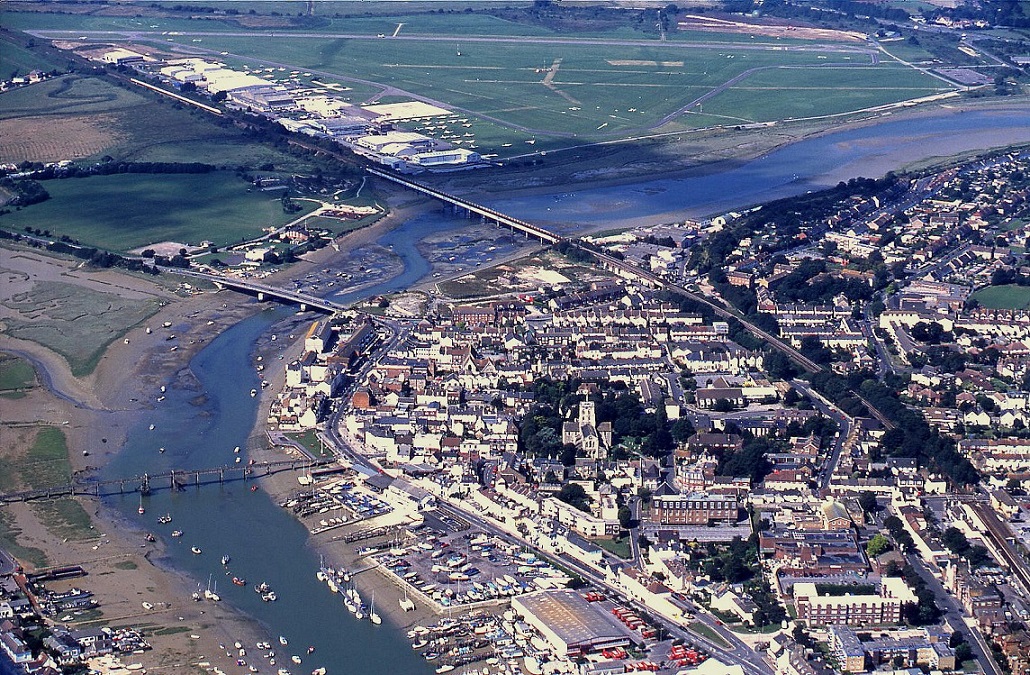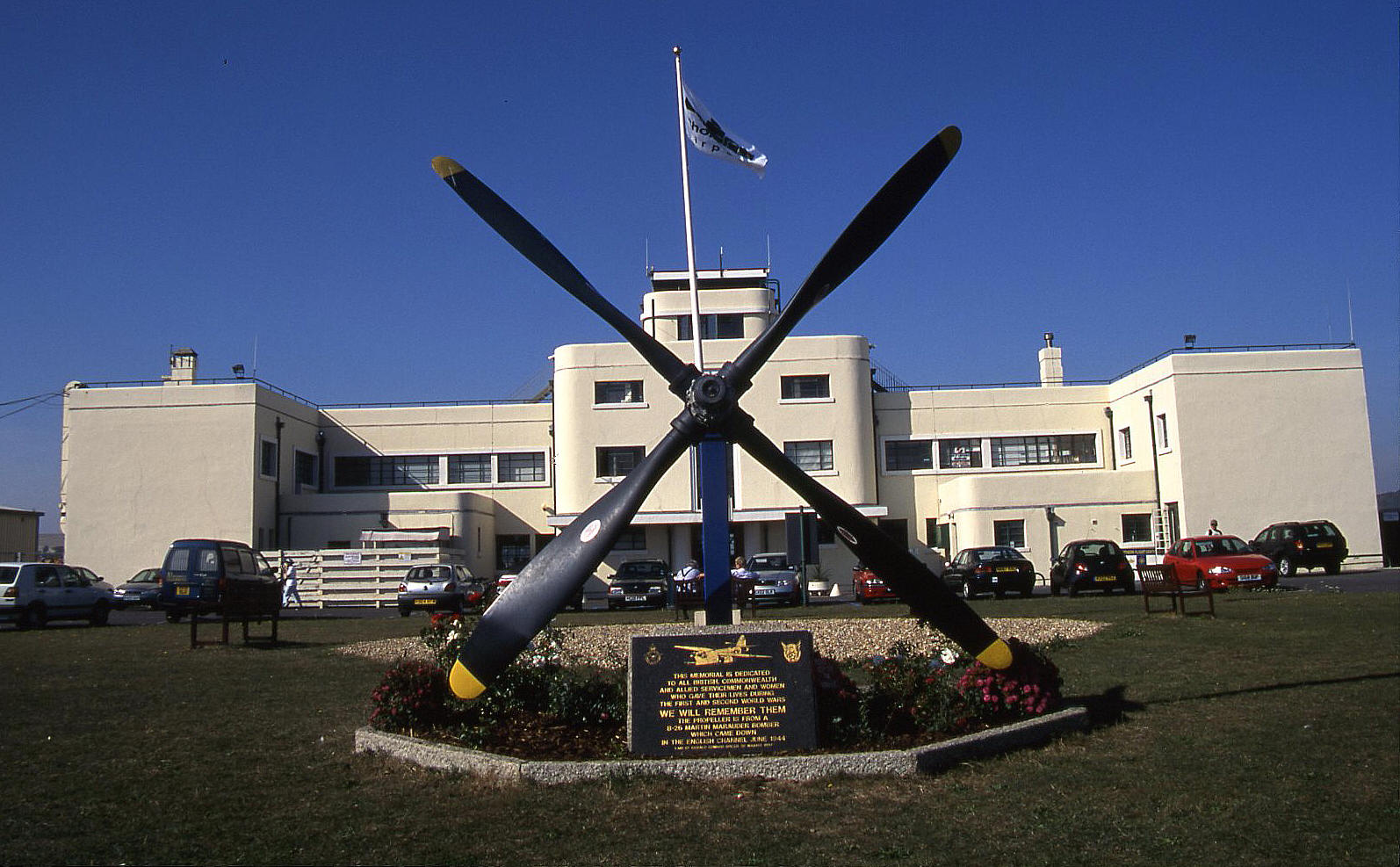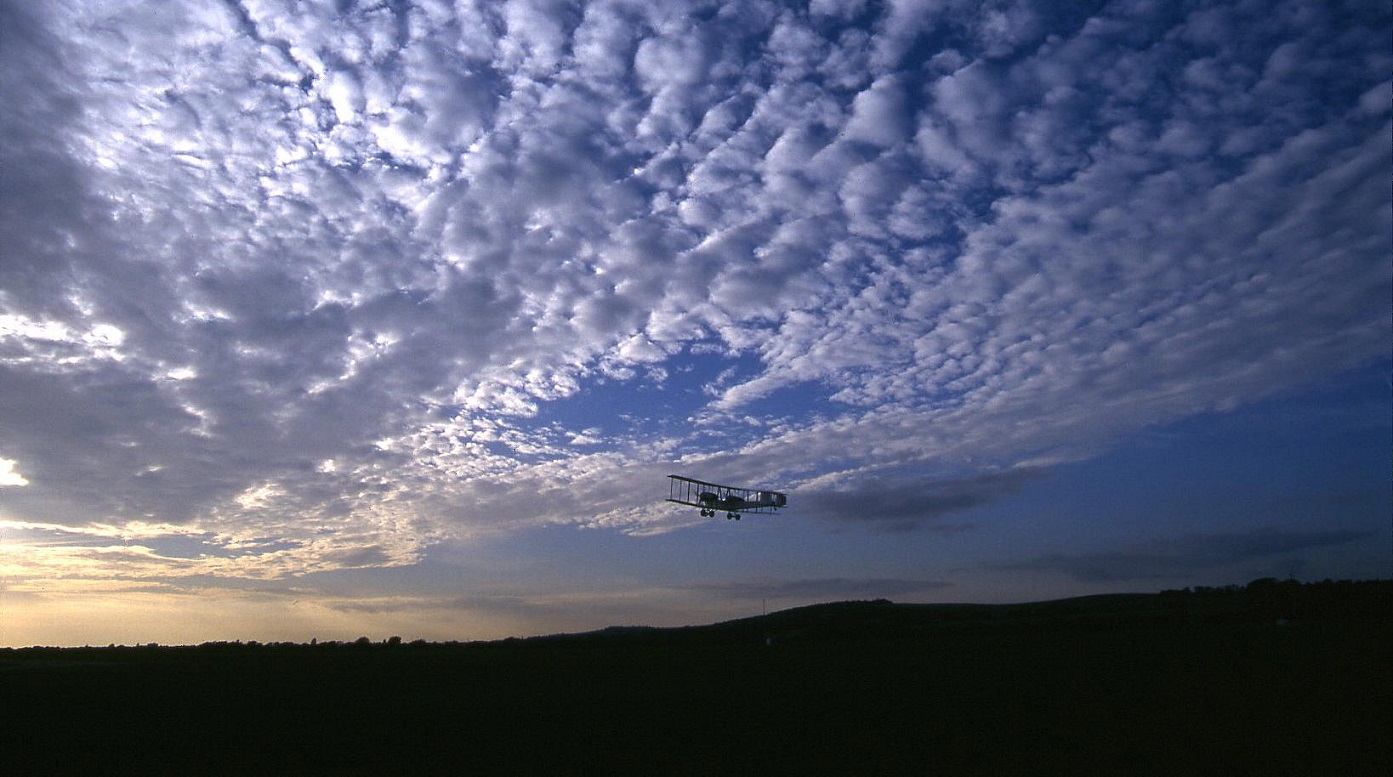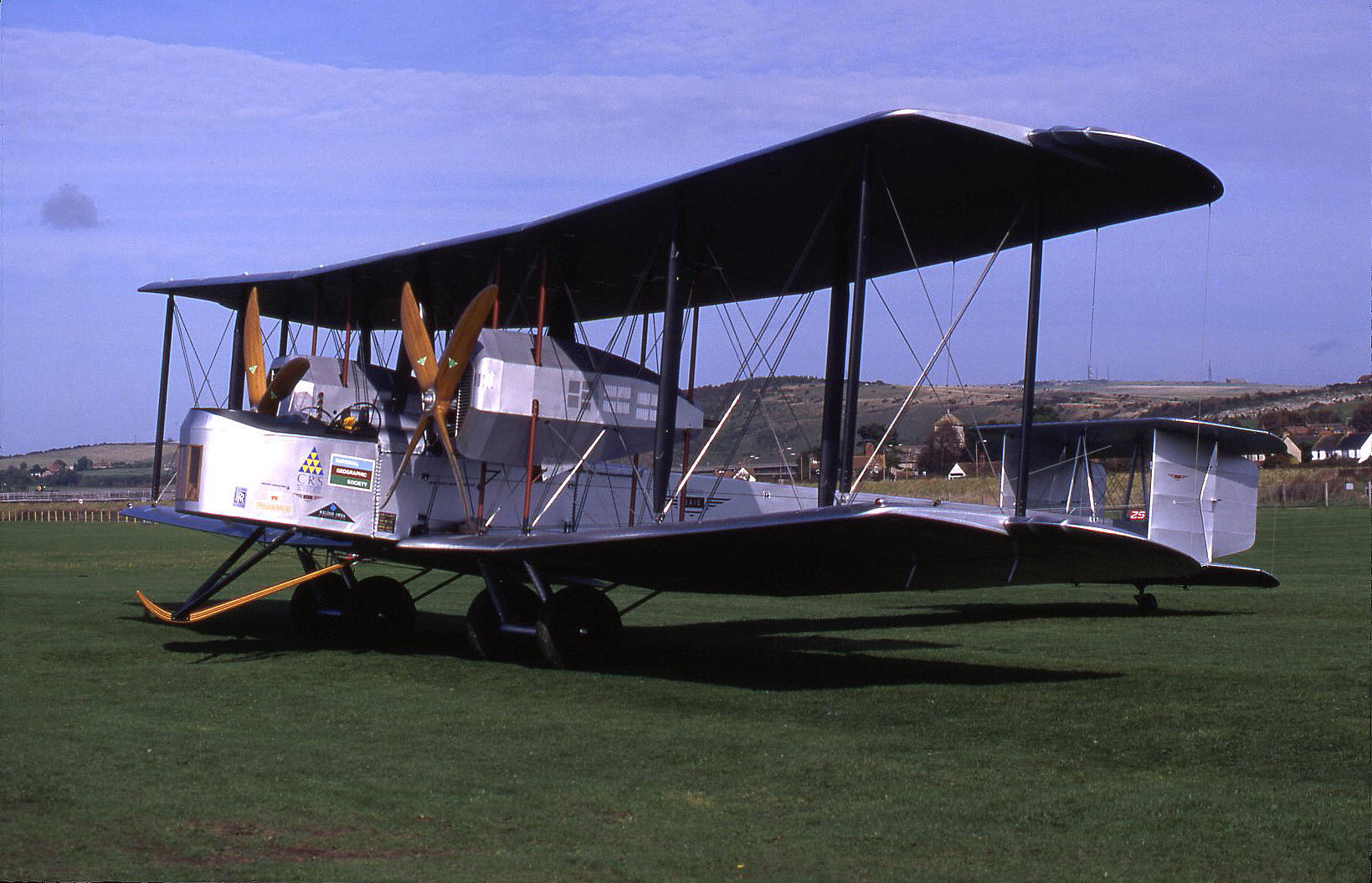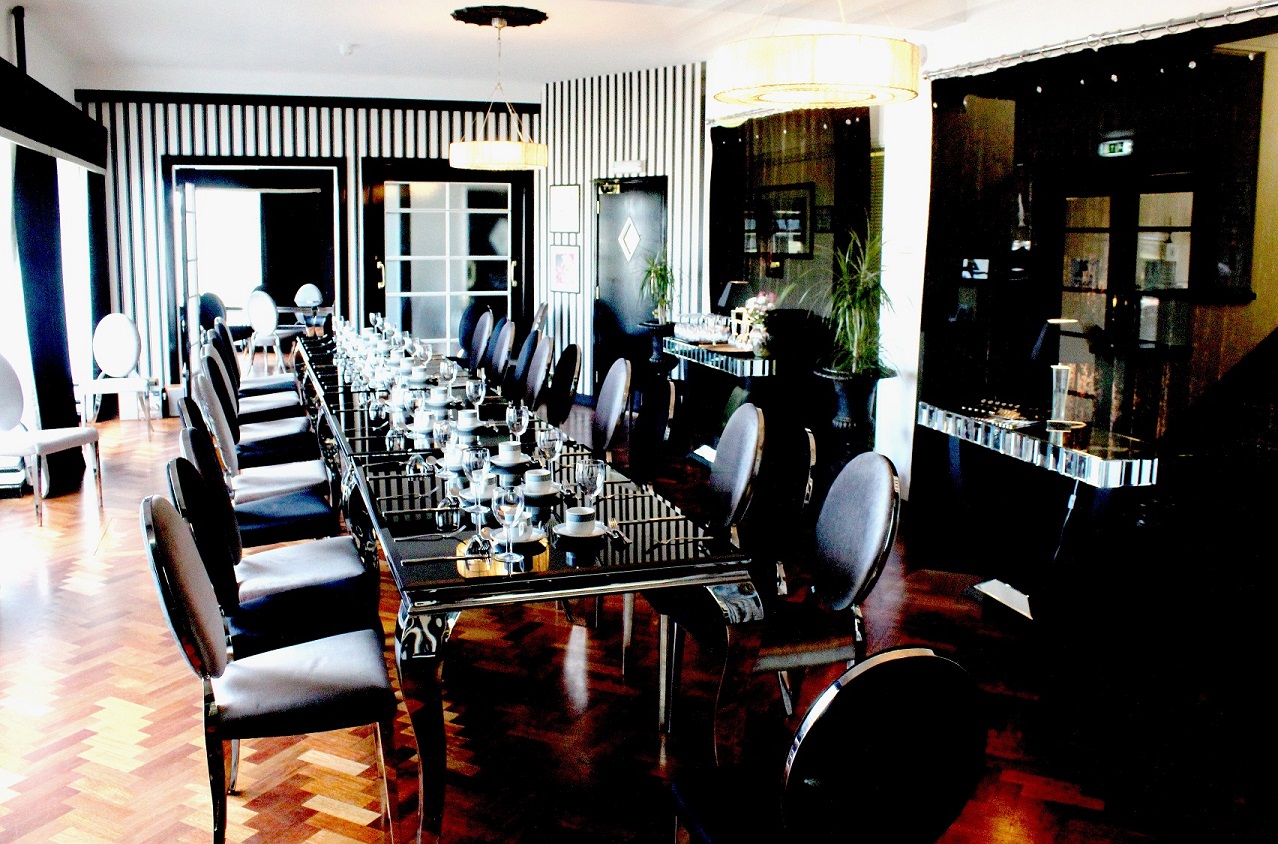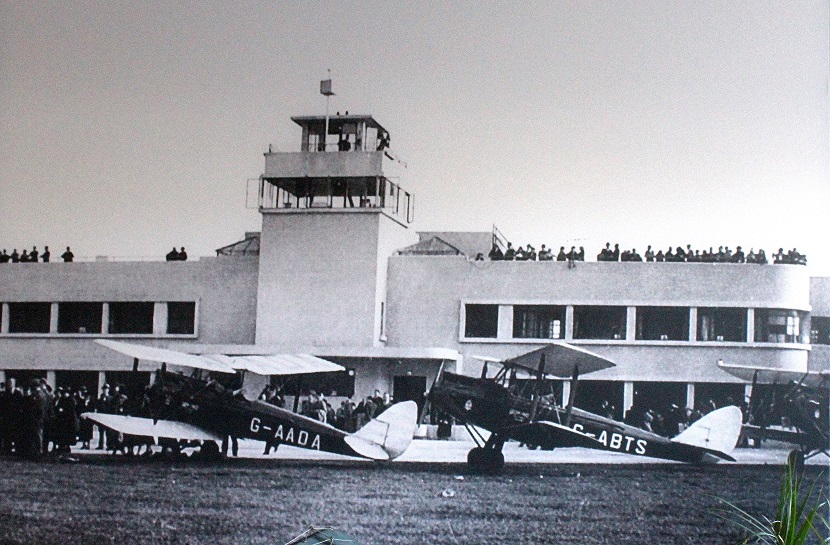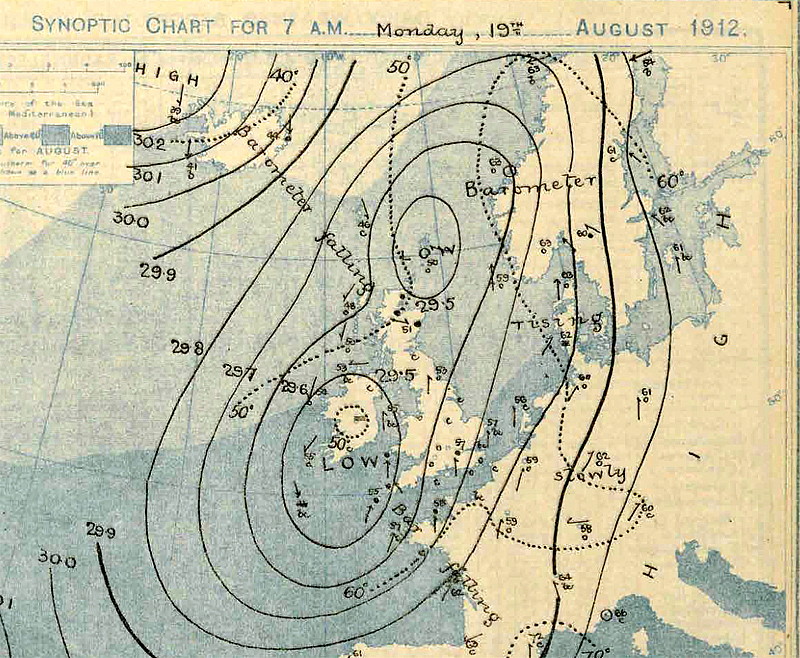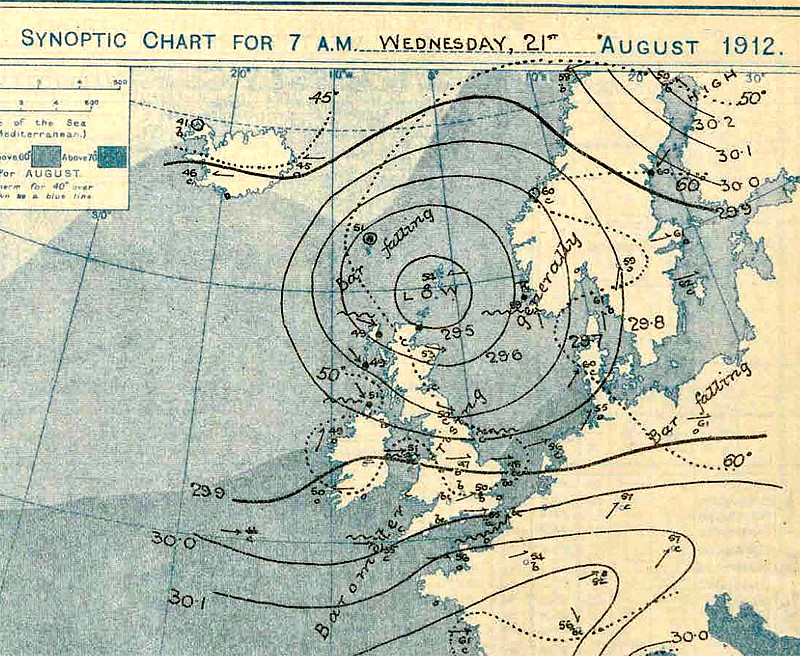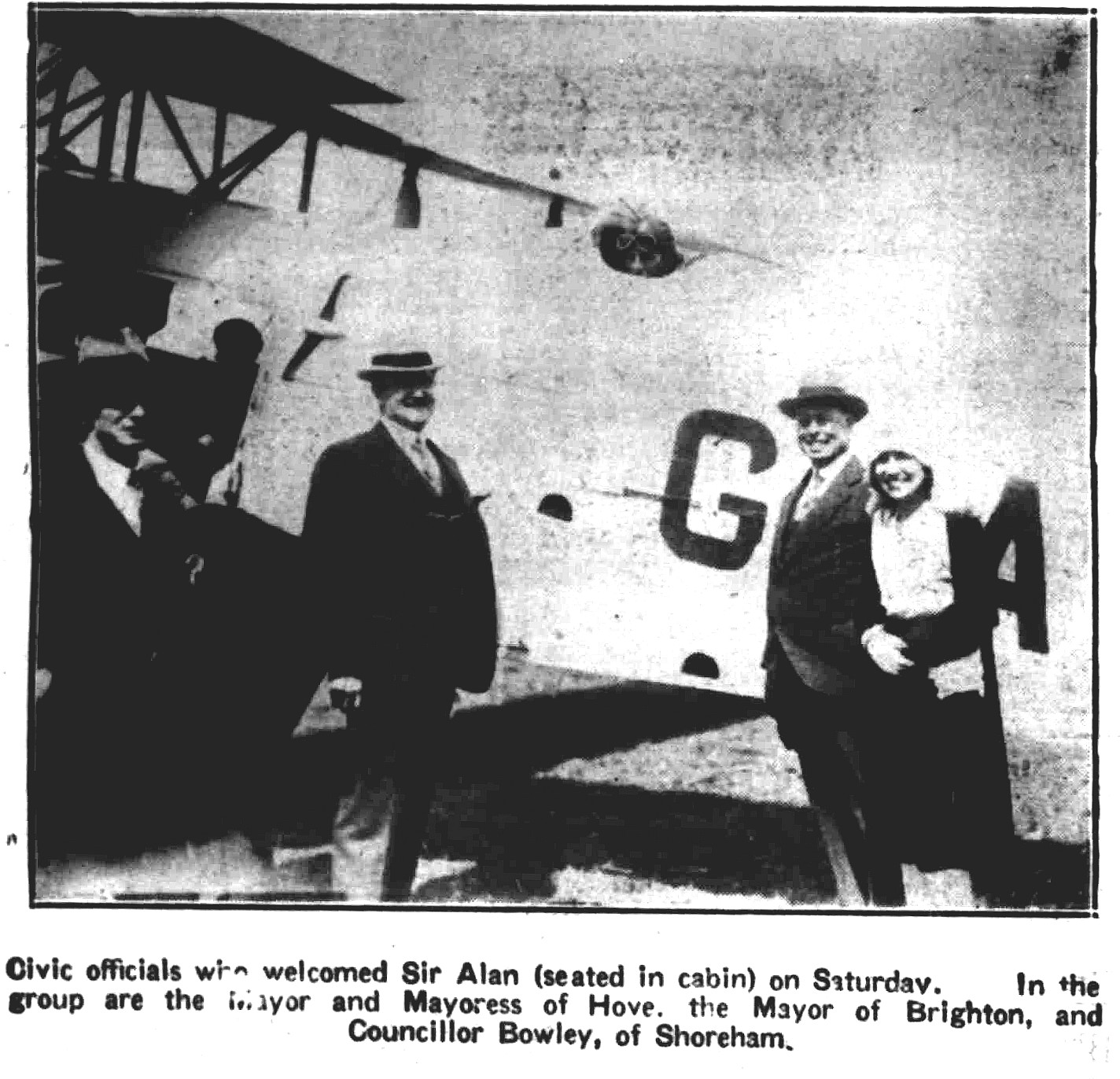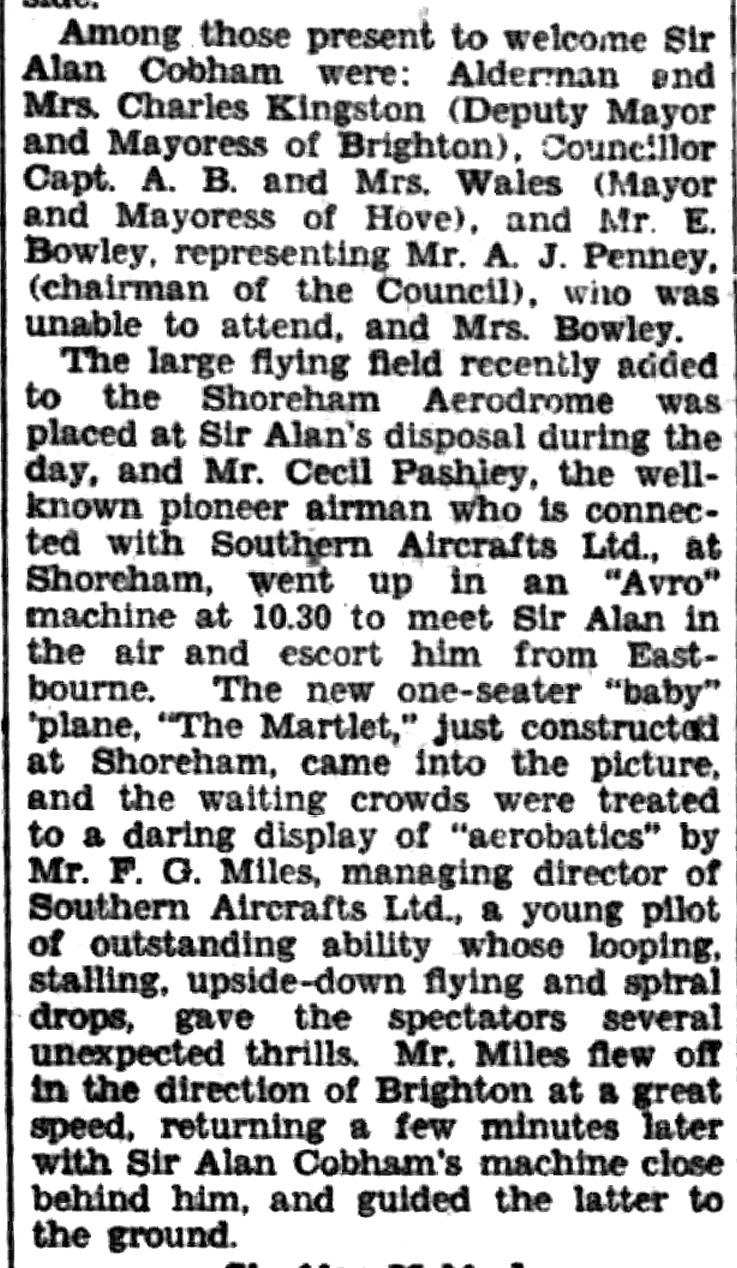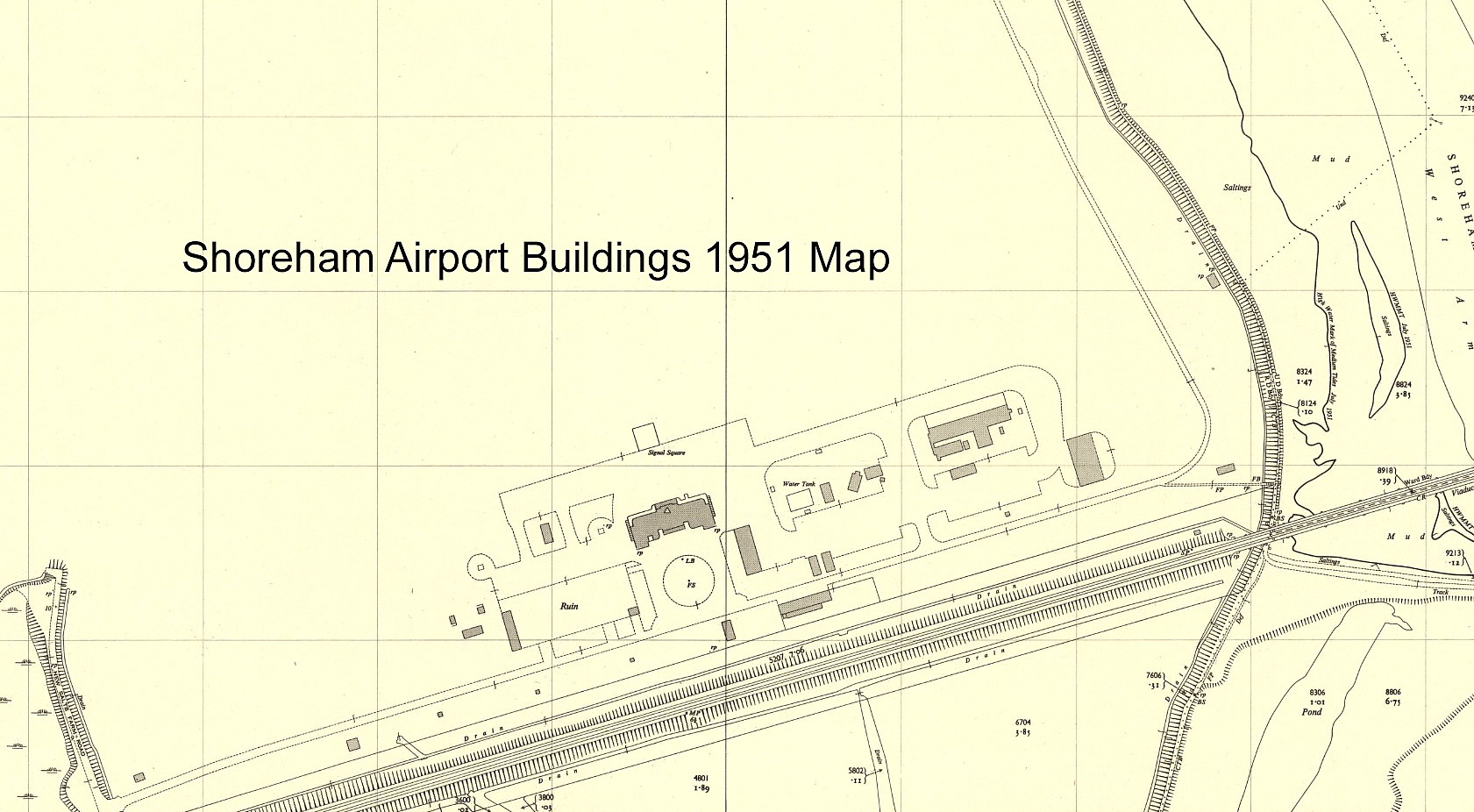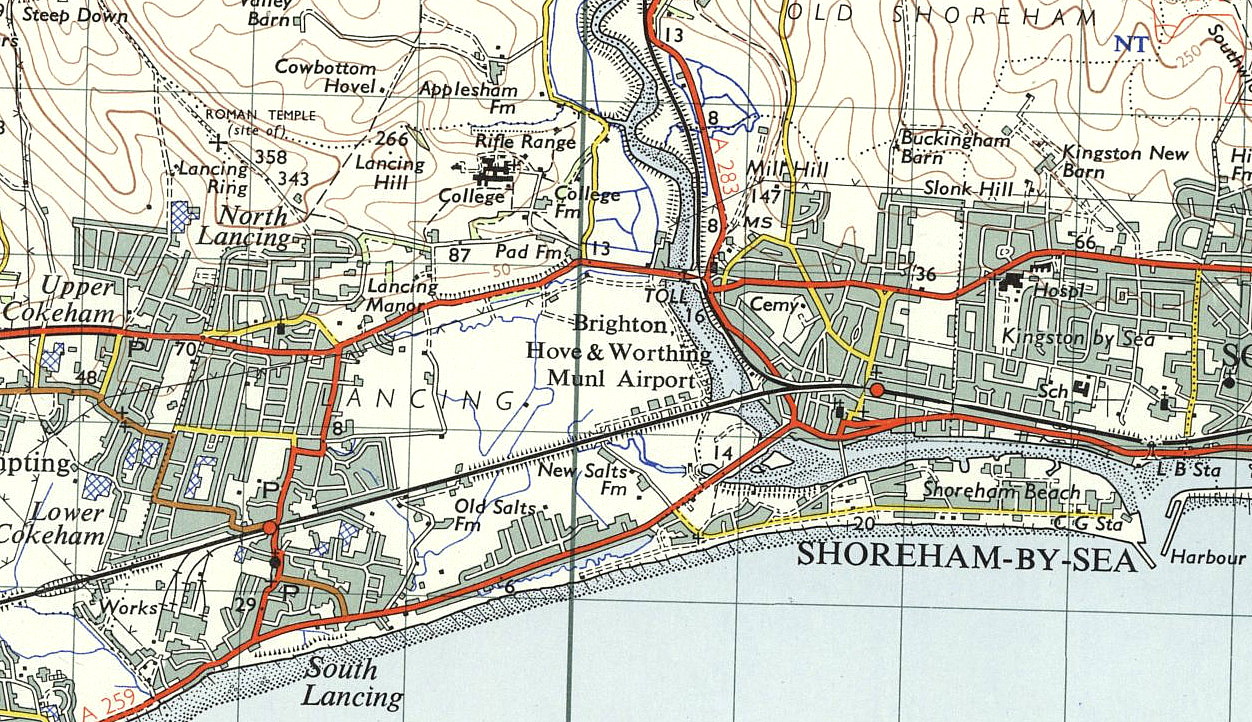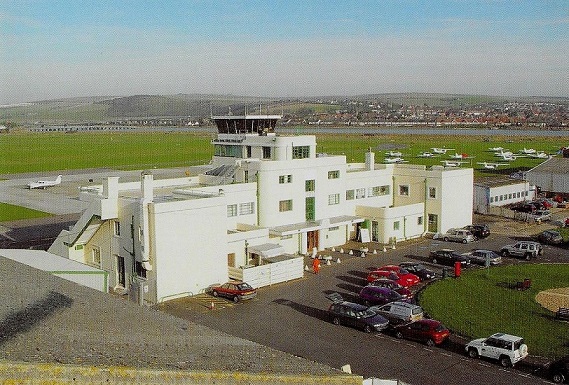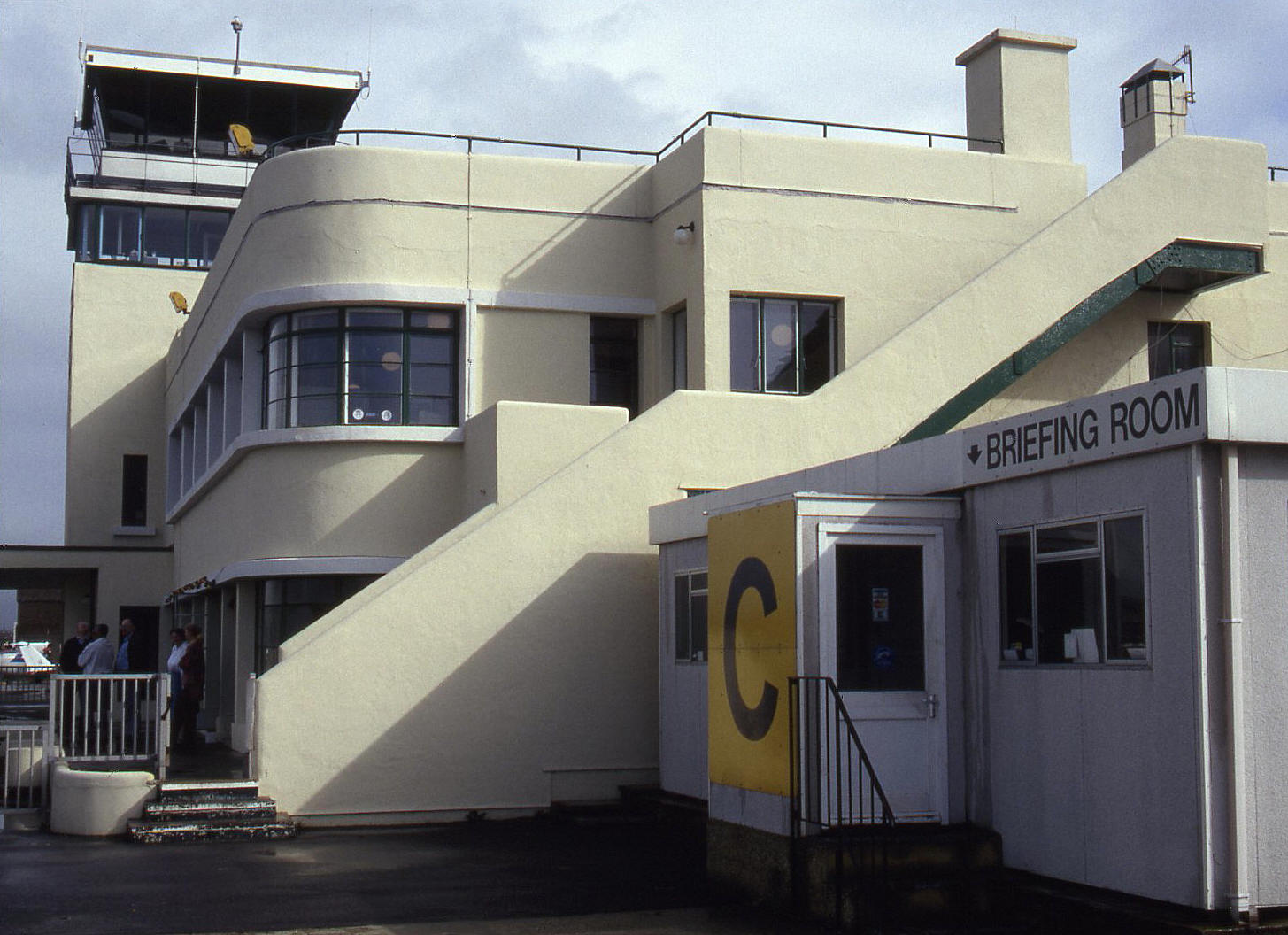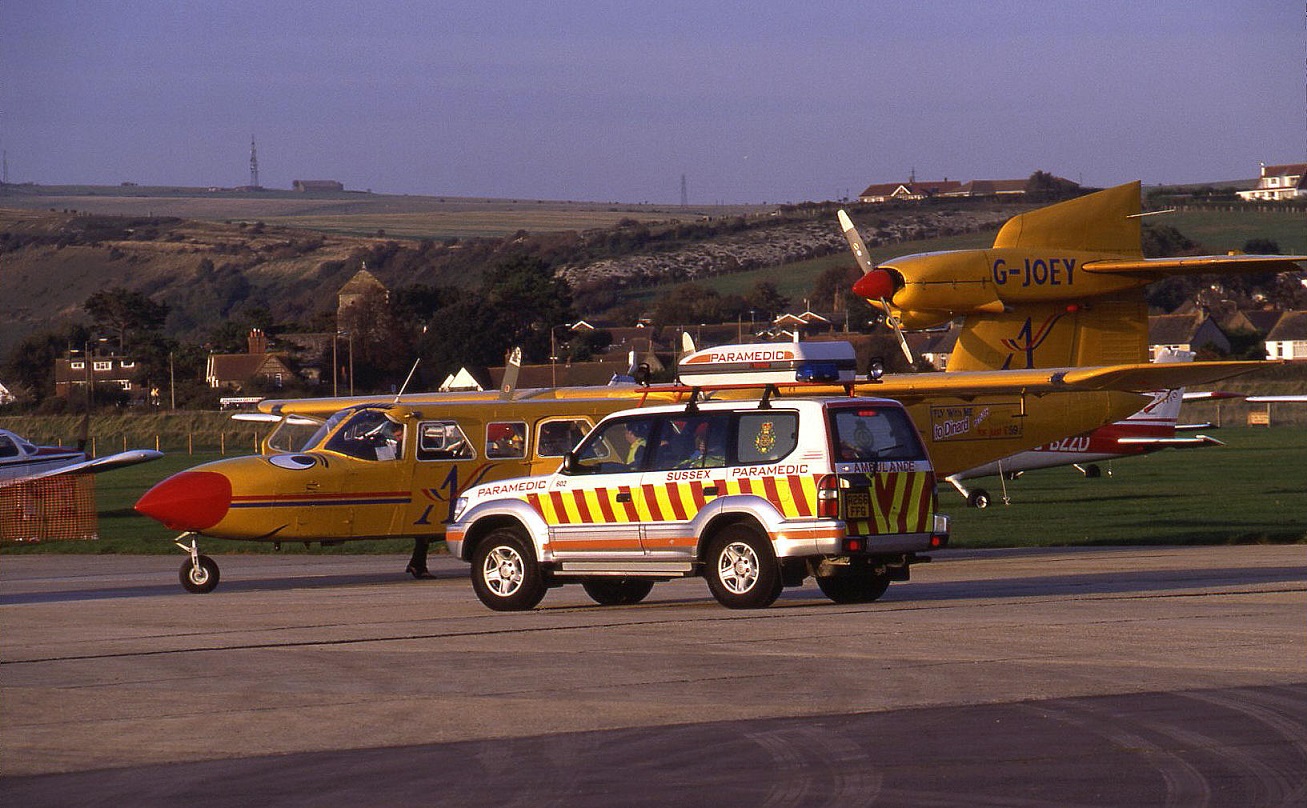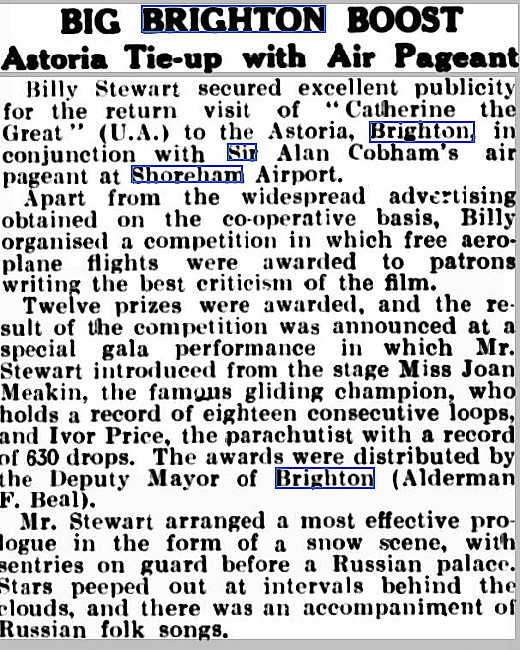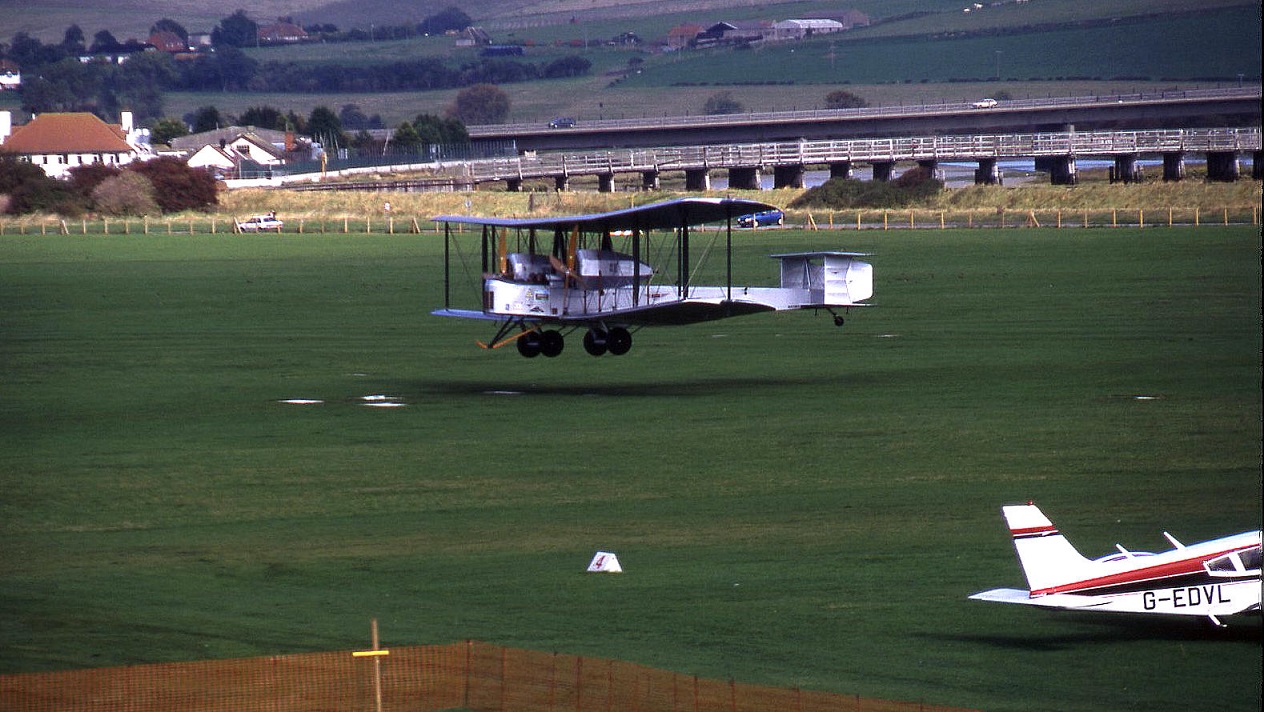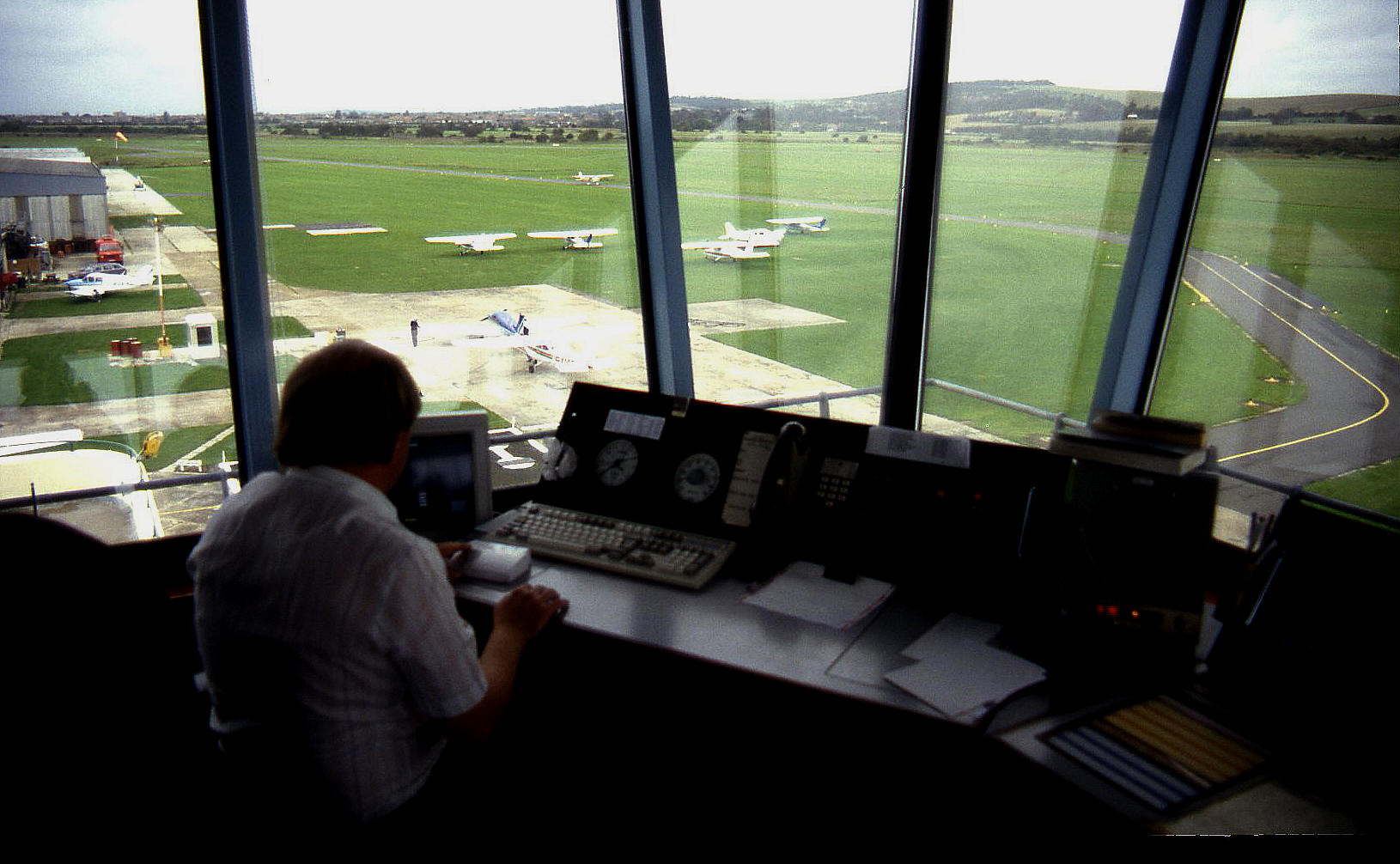Shoreham
SHOREHAM: Originally an early experimental flight site, soon after busy civil aerodrome. In this period known as THE BRIGHTON-SHOREHAM AERODROME. In 1910 known as SHOREHAM AVIATION GROUND. In WW1 mainly a military aerodrome, then civil regional airport, military aerodrome again in WW2. Subsequently regional airport although scheduled services ceased for many years until April 2005. Busy GA aerodrome since shortly after WW2.
Note: This picture (2015) was obtained from Google Earth ©
The aerodrome was renamed as the BRIGHTON, HOVE & WORTHING JOINT MUNICIPAL AIRPORT and officially opened as such on the 13th June 1936. However, I do not know how long this status existed -possibly withdrawn during WW2? Post-war mentions simply record it as being 'SHOREHAM AIRPORT'.
In recent years renamed once again, this time as SHOREHAM (BRIGHTON CITY) AIRPORT. On seeing this I queried the description as traditionally to be accorded 'city' status the town it had to have a cathedral - which Brighton certainly does not possess. However, times have changed and it appears that in 2001 Queen Elizabeth II granted city status on the combined Brighton and Hove conurbation.
Note. All pictures by the author unless specified. The Cherokee (see below - sixth picture) owned by Lee Merritt who created this web-site was used for aerial photography in Surrey and Sussex in October 2016. It is seen here on the apron at SHOREHAM about to be refuelled with Lancing College beyond. Thanks to digital photography, I can now take pictures through perspex and obtain a reasonably sharp image - with a fair bit of post-editing of course.
Official name in later years SHOREHAM (BRIGHTON CITY) AIRPORT.
ICAO code: EGKA
Military users: WW1: RFC 6th Home Defence Wing Station Training Squadron Station (1914 to 1920)
Shoreham Military School
78 [Home Defence] Sqdn (1916 to 1917) (Royal Aircraft Factory B.E.2 and B.E.12 types)
Note: It seems possible that 78 Squadron may have flown their Sopwith 1½ Strutters here as they arrived to replace the B.E. types.
WW2: RAF Fighter Command 11 Group
277 [Air-Sea Rescue] Sqdn (Supermarine Walrus & Vickers-Supermarine Spitfire)
Operated by: WW2 to ?: Air Ministry
1965: Beagle Aircraft Ltd
1980 to 2000: Brighton, Hove and Worthing Joint Municipal Airport Committee
This airline route map was provided by Dr. Anne Tarver: Nottinghamshire County Archive Service:
British airline users: Pre 1940: Channel Air Ferries, Great Western & Southern Airlines, Guernsey Airways, Imperial Airways, Jersey Airways, Olley Air Service, Portsmouth, Southsea and Isle of Wight Aviation, Railway Air Services and West Coast Air Services
During WW2: Jersey Airways, it appears, were operating services to the Channel Islands after war with Germany had been declared. Almost certainly during the 'Phoney War' period and quite possibly until the Germans invaded to occupy the Channel Islands from the 30th June 1940..
Post 1945: Air Enterprises, Blue Island Airline, Channel Airways (Channel Express), East Anglian Flying Services, Euroexec, J F Airlines (later JFA)
Note: I cannot put a date on the pictures, all taken by David Mark, featured on this postcard. The terminal building opened in June 1936, the lovely Piper J3C Cub G-BDJP, and the MBB Bo 105DBS/4 operated by Police Aviation Services for Sussex Police, (which is I think is G-BASX?) all seem straightforward enough - as was the Polish Air Force MiG-15 at first glance.
I do try on occassions to give a bit of detail to this 'Guide' here and there, but have failed so far to discover the exact identity of this aircraft - not that it matters. What my small investigations did reveal however was that this was not a Russian built Mikoyan-Gurevich MiG-15UTI at all, but a PZL-Mielic version, the SBLiM-2 Midget, built in Poland.
Foreign airline users: WW2: DDL Danish Air Lines, KLM, Sabena
Charter/air taxi: Post 1945: Aircruise, Air Taxis International, Brooklands Aviation, CEGA Aviation, Irelfly
Aerial photography: Meridian Airmaps
Note: In the 1957 'The Aeroplane' directory, Meridian Airmaps give their remit as being: "Aerial photography, map-making of all kinds by photogrammetric methods; mosaics and revision, geological survey, high-precision large scale topographical plans and profiles." Their address for the Head Office and Laboratories is given as SHOREHAM AIRPORT. But, no information about the aircraft employed is provided. Can anybody kindly offer advice?
Flying club/schools: 1911 to 1914: A V Roe (Avro) Flying School, Chanter Flying School, Pashley School of Flying, Shoreham School of Flying, South Coast Flying School, Sussex County Aero Club
Pre 1940: Airwork, Gnat Aero Company, Southern Aero Club, South Coast Flying Club
Post 1945: Airbase Flying Club, Brookside Flying Group, PremiAir Flying Club, Shoreham School of Flying, Sky Leisure Aviation, South Coast Flying Club, Southern Flying Centre, Southern Air, Sussex Flying Club, The Flying Hut, The Real Flying Company, Warbird Flying Club
1959 ‘snapshot’. Southern Aero Club. It appears that only this Club was operating here in 1959?
In the 1957 'The Aeroplane' directory, the Southern Aero Club fleet was given as: Three DH82A Tiger Moths, one Miles M.14A Hawk Trainer 3 and one Auster.
Helicopter ops: British Caledonian Helicopters, FAST Helicopters, Spooner Aviation
Note: British Caledonian Helicopters operated, at least, the Agusta-Bell 206B JetRanger G-AWJW from the 8th October 1970 until the 5th August 1980. It was then registered to Spooner Aviation at SHOREHAM until the 17th June 1981.
Note: I flew down from WYCOMBE AIR PARK in the Cessna 152 G-WACA with one of their instructors on the 5th July 1990, so that he could renew his helicopter rating. In G-HFLA as it turned out. Having succeeded in this he then treated me to a local flight in this helicopter; my first flight in a helicopter. I have no idea about the legalities, (he was serving in the CID so obviously would not do anything illegal), helicopters can do things quite impossible in fixed wing aircraft, but needless to say he opened up a totally new dimension to powered flight. Fabulous and most enjoyable.
Other users: Pre 1940: Coastal Flying Boat Services, Southern Aircraft
Flying group: Southern Strut Flying Group
Manufacturing: It is claimed that prior to WW1 the A V Roe company used SHOREHAM, (and other sites), to assemble and flight test new aircraft in conjunction with their flying school. One example was the monoplane constructed for Lieut Burga of the Peruvian Navy which first flew on the 12th November 1912. It now appears, (see below), that Lieut. Burga kept his 'special' Avro at SHOREHAM.
It is discovering items like this that now convinces me that people like Michael Bentine and Spike Milligan were mostly concerned with producing documentary programmes!
Note: However, In 2017 I found this account by Harald Penrose in his excellent book: British Aviation - The Pioneer Years, first published in 1967. This relates to 1913: "....the Avro organisation - which had just been converted into a private limited company with capital of £30,000 - was gratified to recieve a further order from the War Office for five 50-h.p. Gnome-engined Type 500 biplanes as an addition to the order for four recieved the previous year. As a result, they were looking for larger premises. To give temporary space for constructional work at Brooklands, the Avro School of four biplanes was transferred to Shoreham."
F G Miles Aircraft (1925-1931) and later, (1952 – 1961?), BEAGLE/Miles and BEAGLE/AUSTER and later known just as BEAGLE.
Maintenance: Pre 1940: Gnat Aero Co
Post 1945: AS Engineering, Jade Air, KB Air, Sern Air, Tyrell Aviation
Location: S of A27, W of River Adur and Shoreham by Sea, 6 nm W of Brighton
Period of operation: 1910 to present day (some say from 1911)
Site area: WW1: 191 acres 1006 x 594
Note: These maps are reproduced with the kind permission of Pooleys Flight Equipment Ltd. Copyright Robert Pooley 2014.
Runways: WW2: NW/SE 1097 grass NE/SW 1052 grass
1965: 03/21 1052x122 grass 08/26 1052x122 grass 14/32 799x122 grass
1990: 03/21 824x18 hard 07/25 909x50 grass 13/31 425x30 grass
2000: 03/21 1036x18 hard 13/31 700x18 grass 07/25 909x50 grass
13/31 400x30 grass (Runway 07 has 60m & runway 31 128m starter extensions)
Also, by 2000 the 03/21 hard runway now had a 700m unlicensed grass runway running parallel to the east
SHOREHAM TERMINAL ASPECTS 2016
NOTES: Apparently SHOREHAM was first used by “Mr H Pifford” in 1910 for trial flights with his biplane. He had previously been based in NORTH EALING (LONDON). This unfortunate gentleman has had his surname spelt as Piffard, Pifford and Pilfard. I now think Piffard is most probably correct? He is certainly credited with being responsible for inaugurating flying activities, both land and water based, at this historic site. It appears he built at least two landplanes before building the Piffard Hydro-biplane in 1911.
These early experiments were, it is claimed, not successful, and indeed this appears the case for both his landplane designs; the best results being ‘short flights’ for his second design in May 1910. In NORTH EALING he only achieved ‘controllable’ hops and we must of course remember that so-called ‘short flights’ in those days were invariably extended ‘hops’ and not flights at all in the definition, generally accepted, that we use today. (See below to appreciate what Mr Piffard started).
It appears the British & Colonial Aeroplane Co, (Bristol), occupied two sheds here in 1911. A V Roe moved his Flying School from BROOKLANDS to SHOREHAM in 1912.
THE FIRST LONG DISTANCE CHARTER FLIGHT?
Please see my entry to STEYNING
THE ROUND BRITAIN RACE 1911
This picture was scanned from The History of British Aviation 1908 to 1914 by R Dallas Brett.
In 1911 the Daily Mail offered a fabulous prize of £10,000 (about £1.5 million in 2024) to the winner of a race around Britain. Of the thirty entrants just twenty-one departed from BROOKLANDS on the 22nd July. The control points were Hendon, Harrogate, Newcastle-upon-Tyne, Edinburgh, Stirling, Glasgow, Carlisle. Then Manchester, Bristol, Exeter, Salisbury Plain and Shoreham before arriving back at BROOKLANDS.
Pilots from the UK and France dominated the field plus one each from Switzerland and Austria. From the very start it was clear that the French pilots, in their French machines with French engines were superior. Indeed, "Beaumont" (actually Lieut. de Vaisseau Conneau) and Jules Verdrines were soon ahead of the others, (sometimes with Verdrines in front), and "Beaumont" eventually won. Verdrines was awarded a £200 consololation prize. Two British pilots followed, Valentine landing two days later and Cody the next day. The American Samuel Cody having taken up British citizenship in 1909.
MORE EARLY HISTORY
In his most useful book British Built Aircraft Vol.3 Ron Smith gives this account of SHOREHAM: “Shoreham Aviation Ground dates from 1910, and was the scene of significant pioneer flying, being third only in importance to Brooklands and Hendon.” A rather surprising comment as elsewhere, Ron Smith in his series of books, and quite possibly in this volume, makes the point that the activities at SHELLBEACH and later EASTCHURCH on the Isle of Sheppey (KENT) were hugely important in the development of British aviation. I would add LAKE WINDEMERE on the WESTMORLAND shores.
He goes on to quote: “In September 1911, it was advertising as follows; ‘Brighton-Shoreham aerodrome – railway station right on aerodrome, tenants share in gate money, large expanse of water available for hydro-aeroplanes.’ Uniquely, it has been in more or less continuous use (albeit with differing boundaries, and a break between 1921 and 1925) since 1910, and in 1996 celebrated sixty years as the municipal airport of Brighton and Hove.”
Ron Smith also explains, “The Chanter Flying School moved to Shoreham from Hendon on November 1911, initially with three Blériots plus their own monoplane. The School also acquired the Aeronautical Syndicate Viking I and fitted it with floats and a single propeller. The Chanter monoplane made its first flight on New Year’s Day 1912 at Shoreham. A fire ended the short residency of the Chanter School on the night of 29 February 1912, destroying three hangars and the Chanter monoplane.
Again quoting Ron Smith, “Basil H. England and a Mr Collyer built a tractor biplane, known as the Collyer-England biplane, which was tested at Shoreham from August 1911.” It seems the aircraft was not very successful and was damaged in early April 1912. But, it appears the pair were undaunted and in the same month adopted the name, ‘South Coast Flying School’.
The first ‘official’ record I had found relating to SHOREHAM was when Hans Rolshoven was granted Pilot Certificate No.560 here flying a Avro Biplane. In 1912? However, Ron Smith comes up with this: “An Aeronautical Syndicate Valkyrie B was used on 4 July 1911 to carry the first cargo by air in Britain – a box of OSRAM lamps from Shoreham to Hove, the machine being flown by Horatio Barber.”
THE GALLERY OF EARLY PICTURES
In the terminal building, in a corridor running parallel with the Art Deco dining room, there are several wonderful pictures of the early days. Please see here a selection, taken through glass needless to say, reflections and all, but I trust you will find them of great interest. The eighth picture is a scan from a postcard - see notes below.
Notes: The first picture, of the sheds, (which hangars were called prior to WW1), was presumably taken before WW1, and clearly shows a couple of the 'sheds' occupied by Avro.
The second picture is of the Lee-Richards Annular biplane. It appears that this design did not succeed in flying here, and was taken to Southport (LANCASHIRE) for further trials. It appears that a monoplane version did fly, but I can find no mention of where this took place. Can anybody offer advice?
The third picture is of Edith Meeze, an early aviatrix seated on the Valkyrie B Monoplane, probably circa 1911. It seems to be largely forgotten that women played a quite significant role in early aviation prior to WW2, and of course, still do.
The fourth picture shows the clubhouse and restaurant, pre WW1. The restaurant was it appears, originally the No.2 hangar. Both of which were situated in the SE corner of the aerodrome.
The fifth picture is of spectators gathering in 1911 to veiw aircraft competing in the "Circuit of Europe". The fencing seen behind and running along the banks of the River Adur was erected to prevent non-paying spectators from viewing the proceedings.
The seventh picture isn't in this gallery; it is instead a huge 'blow-up' placed upon the wall at the western end of the cafe. This picture was taken in the early 1930s and shows two de Havilland DH.60G Gipsy Moths, G-AADA and G-ABTS. G-AADA was registered in November 1928 and crashed in 1936. G-ABTS was registered in 1932 and went on to be requisitioned in WW2 for use by the RAF.
The eighth picture is a scan of a postcard; "A limited edition print of 1,250, exclusively available from Shoreham Airport." I have no idea now of when and where I obtained this postcard, but the main caption states; "THE BRIGHTON HOVE & WORTHING JOINT MUNICIPAL AIRPORT OPENED 13th JUNE 1936." Then a list of the names of the three town mayors attending.
Another detail in this picture shows an odd coincidence. At the left hand side can be seen the rear fuselage and tail of G-ACPR, a D.H.89 "Rapide" according to official records of the time. Today of course we tend to lump these variants together as DH89A Dragon Rapides. Also, we tend to regard the type as being a 'pilot plus five to seven pasengers' but the pre-war C of A (Certificate of Airworthiness) describes it as being a nine-seater - presumably including the pilot?
The coincidence is this. At the time this picture was taken G-ACPR belonged to Railway Air Services and was based at CROYDON. It served with them from the 20th February 1935 to the 5th December 1938. Then, from the 31st January 1939 it was registered to Great Western and Southern Airlines, based at SHOREHAM AIRPORT, being "withdrawn from service" on the 18th February 1940. Or - was it impressed for military service?
A VISIT BY HENRI SALMET
By August 1912 Henri Salmet was one of the top and most famous aviators in the U.K. and, along with Claude-Grahame White, had been sponsored by the Daily Mail to tour England during the summer season. By the time he reached SHOREHAM where he stayed from the17th to 21st August, he had become a very proficient flyer and as the newspaper reports below show, even really quite poor flying conditions rarely failed to defeat him.
These three articles were published in the Brighton Gazette. We have Mike Holder, a great friend of this 'Guide' to thank for providing these articles and the three synoptic weather charts below.
As these three charts clearly show, the weather during this period was very far from ideal. (Often quite typical for August in the U.K. of course).
However, Salmet declared that high winds, (and associated low level turbulence), did not much bother him. If anything was going to force him down, it was heavy rain. Hardly surprising perhaps when you consider he was flying his Blériot sitting quite high up and fully exposed to the elements. Indeed, in those days pilots were usually described as being 'on' their machine, rather than 'in' it. And of course, in such conditions needing both hands on the controls, a pilot could not spare a hand to continuously wipe the rain from his goggles, so in effect he would be flying nigh on blind.
ALLIOTT VERNON ROE AT SHOREHAM
Quite possibly few today realise the association between SHOREHAM and the A V Roe (Avro) company? Ron Smith gives a detailed account: “A.V.Roe & Co. Ltd used Shoreham for seaplane testing, and as the base for the Avro Flying School from October 1912. Contemporary advertising included: ‘Avro – Nothing Better’ and in March 1913: ‘Avro Flying School: Real aeroplanes, no boxkites. Avro Flying School (Brighton) Ltd.’ This is obviously an aggressive attack on the highly successful Bristol Flying Schools? Interesting to note, I think, that even in those very early days fierce competition for the few prepared to learn to fly existed?
To quote Ron Smith again: “The school used the Avro Type D biplane, and later the Type E prototype and production Avro 500. The Type E was destroyed here at the end of June 1913. One of the school instructors was John Alcock, later to fly across the Atlantic with Arthur Whitten-Brown in the Vickers Vimy that is preserved in the Science Museum. A. V. Roe & Co. Ltd used Shoreham to test floatplanes, including the Avro 503 first flown on 28 May 1913, which was also known as the 100hp Avro ‘Waterplane’. The Avro School left Shoreham in September 1913.” Ron Smith also mentions the Avro-Burga monoplane built here for Lt. R Burga of the Peruvian Navy and first flown on the 11th November 1912. (Others reckon it flew on the 12th November).
THE RADLEY-ENGLAND WATERPLANE
Ron Smith tells us; “The Huntingdon-built Radley-England Waterplane was flown very successfully from the River Adur at Shoreham. The aircraft featured a twin-hull design, initially with three Gnome engines, and space for six occupants (three in each float, with the pilot at the front of the starboard float). The Waterplane was rebuilt with a single 150hp Sunbeam driving a Lang propeller for the 1913 Daily Mail Round Britain race. The floats (or hulls) were built by The South Coast Yacht Agency. The Radley-England works occupied three sheds at Shoreham and were taken over by Cedric Lee in 1913/14.”
THE LEE-RICHARDS ANNULAR MONOPLANE & THE DYOTT
C C Turner informs us (in around 1929) that the rather amazing Lee-Richards Annular Monoplane, (with a circular wing) was built here in 1913 under great secrecy it is said. Designed by Mr Tilgham Richards and Cedric Lee it was built by Gordon England and was crashed by Captain C Gordon Bell when the engine failed. According to C C Turner three versions were built, (the last probably out of many parts from the previous two?), and, “It proved very satisfactory in flight.” And, “Altogether some 1000 miles, 128 hours flying, was done on the three Shoreham machines.”
The Dyott monoplane was at Shoreham in 1913 and then it seems toured in the USA. It was back here making demonstration flights in July 1914. This aircraft was built at the Hewlett & Blondeau works in Clapham Junction, London and was first flown at HENDON (LONDON).
A VERY STEEP LEARNING CURVE
It must be said that having started this ‘Guide’ as a complete amateur in or around 1992/3 I had absolutely no idea about how the project would grow, and grow - and grow. And, as the task went on, realising just how very little I actually knew about our aviation history and heritage - despite being interested in the subject all my life. This said, as as the years passed by researching this 'Guide' I have been constantly delighted by so many totally unexpected discoveries. Perhaps one of the best examples being, in Ron Smith’s British Built Aircraft Vol.3 - the Wong ‘Tong Mei’ which he describes as; “…an attractive two-bay biplane powered by a 40hp ABC engine and.....tested at Shoreham in spring 1913. ‘Tong Mei’ is Chinese for dragonfly. The type was followed in 1914 by a much more powerful two-seat derivative powered by a 100hp Anzani engine. Mr Wong was Australian-born of Chinese extraction and learned to fly at the Collyer-England school.” Some years ago I had a trawl through the usual suspects for that period, BROOKLANDS, EASTCHURCH, HENDON etc, but could not find any mention of the ‘Collyer-England School’. Ron Smith says; “A company, T K Wong Ltd, was formed in December 1913, presumably to promote the design.”
CECIL PASHLEY
Yet again I find that it is much easier to quote from Ron Smith in book British Built Aircraft Vol.3 regarding the remarkable Pashley dynasty at SHOREHAM which, for Cecil Pashley, spanned six decades! “Eric and Cecil Pashley built their own biplane at Shoreham in July 1914. The aircraft, which was strongly reminiscent of a Farman Shorthorn, was known as the Pashley Brothers biplane. This aircraft was used as a trainer and for joy riding by the Pashley School, which had moved to Shoreham from Brooklands in 1913.” A paragraph later Ron Smith says that, “Cecil Pashley first came to Shoreham in 1911.”
The Pashley School started here, in 1911 as well as having a base at BROOKLANDS. Ron Smith points out: “Other aircraft operated by the Pashley Brothers included: Anzani Blériot (1910), Lane monoplane (January 1911), Universal Aviation Co. Sommer biplane (mid-1911), and a Humber monoplane (mid-1912).” It also appears unclear where these aircraft were operated from? Were they used at SHOREHAM or at their School in BROOKLANDS (SURREY), or perhaps even at both? In those days of course the operational life of many aircraft was often limited, perhaps being used for one flying season only, if they survived that! Crashes were frequent but only rarely was the aircraft a total write-off. Indeed, a ‘small’ crash was often seen as a good opportunity to incorporate modifications and, quite frequently, a change of name for the type usually in favour of the modifier. This explains why so many apparently ‘original’ aircraft bear a striking resemblance to much better known types. A practise that still exists today to some extent.
However, I digress, so back to Ron Smith: “At the time of transferring to Shoreham in May 1913, a Farman biplane was in use, and the Brothers were reported by Flight to be ‘flying busily’ at Shoreham in July 1913. The company name was changed from 1914 to Pashley Brothers & Hale. Ron Smith includes an advertisement for this company and I shall provide a roughly similar facsimile:
TUITION IN FLYING
Write for particulars of our
SPECIALLY REDUCED FEES and BONUS FLIGHTS.
Machines used:- H. FARMAN, AVRO and PASHLEY BIPLANES.
Apply – PASHLEY BROS. & HALE,
THE BRIGHTON - SHOREHAM AERODROME.
He then adds: “Cecil Pashley first came to Shoreham in 1911, and continued to instruct at his flying school, now called the Southern Aero Club, until 1962!
SOUTH COAST AIRCRAFT WORKS
Ron Smith mentions the South Coast Aircraft Works who apparently only built one 80hp Henry Farman (serial 1599) and it seems this company emerged from the remains of the Cedric Lee business who built BE2C wings and Avros during WW1. South Coast Aviation Co were listed as ‘official contractors to the Admiralty and War Office in WW1 but, it seems, didn’t actually build any complete aircraft, the initial order for twelve BE2Cs being cancelled. I had also made this note: Southern Counties Aviation were based here in 1925 but what did they do? The probable answer is that this company was actually Southern Aircraft Ltd?
A MICHAEL T HOLDER GALLERY
My notes: The picture above (18th August 1929) and article (below) in four parts (24th August 1929) were published in the Worthing Herald. These concern the visit by Sir Alan Cobham during his Municipal Aerodrome Campaign that year. Starting in May and ending in October, he had planned to visit 107 venues in the mainland of the U.K. Despite two or three serious accidents, he nevertheless managed to visit around 95 venues. Quite an achievement even so.
It appears he stayed at SHOREHAM for two days, the 18th and 19th August, departing on the 20th. The article below is well worth a read and shows just what a 'star turn' Cobham was in those days. For most of the venues he used the de Havilland DH61 'Giant Moth' G-AAEV, which had to be nigh on rebuilt when he crashed it at Rhyl in North Wales.
MORE MAPS AND PICTURES
THE BETWEEN THE WARS PERIOD
To quote from Ron Smith yet again: “Southern Aircraft Ltd was established in 1926 and produced the Southern Martlet, which was designed in 1929 by F.G. Miles and based on the Avro Baby. The first Martlet G-AAII was first flown at Shoreham on 10 July 1929. The type was well known for spirited exhibitions of aerobatics when flown by F.G. Miles.” I think the following comments are especially interesting; “The type was designed from the outset specifically for aerobatics, being described as ‘the only aircraft built primarily for private pilots who want to stunt’. Flight described the type as ‘amazingly manoeuvrable’. Seven aircraft powered by a number of different engines, were built at the Southern Aero Club.” I think Ron Smith means they were built by Southern Aircraft, not the Southern Aero Club as he describes the functions of the two businesses which I have quoted later on.
If this claim by Southern Aircraft is correct, then the Southern Martlet can lay claim, in the UK that is, to be the first of a ‘smallish family’ of British aerobatic single-seat designs that established a tradition that continues to the present day and will no doubt extend into the foreseeable future. Since WW2 this has been a class largely dominated by US designs, especially the Pitts series for biplanes, no doubt aided greatly by their ‘Experimental’ category allowed by the FAA.
It appears that Mr John C Don conducted ‘barnstorming’ displays from here in 1928/9 with an Avro 504K G-EAJU. In his book Ron Smith illustrates an advertisement for the South Coast Flying Club which appears to come from the 1920s which I would say was of interest on several levels today. The text states; “Come and Fly at the South Coast Flying Club. We still have the BROOKLANDS atmosphere!” What, I wonder, did they mean by, “the BROOKLANDS atmosphere!”? Presumably the pre-WW1 period? And, if so, were they deliberately promulgating a somewhat reckless attitude to flying as invariably exhibited at BROOKLANDS in the early days. I reckon they probably were? Flying in those days was most definitely generally perceived as both a dangerous and adventurous activity. Indeed, many of the ‘general public’ still hold this view, especially regarding GA activity.
For example, in April 2011 I was involved in a film job at LASHAM (HAMPSHIRE) then and still one of the busiest gliding sites in the world. My colleagues expressed severe doubts about ever ‘going up’ in a glider. “Wot…no engine?” Incredible isn’t it? I like to point out that most of the time when in an airliner, once the point of descent from the cruise is reached, (usually thirty minutes out from landing), if everything goes to plan with ATC clearances, you are basically sitting in a glider! An exaggeration of course as the crew don't actually turn the jets off, but, most of the time they are at 'flight idle' and not providing any propulsion. The transition usually comes in when the crew need to slow down for landing, dropping the flaps and undercarriage. In this configuration usually quite a lot of power has to be applied to maintain a controlled decent - which is why jet airliners on finals to land seem to be making so much noise.
AN ALMOST EXTINCT BREED?
Ron Smith quotes an advertisement which I think is well worth repeating as it serves to help illustrate a certain kind of well-healed man of independent means which has largely died out since WW2. Would I be correct in thinking this is largely due to the increasingly competitive, specialised and professional nature of many if not most sporting activities?
“Martlet: High performance single-seat sports light aeroplane fitted with Genet II, Gipsy II or Hermes type engines. Price from £550. Ample locker accommodation for gun, golf clubs, suitcase fitted standard.” Almost certainly the kind of ‘gentleman’ or ‘Toffs’ sort after by the RAF leading up to WW2 as desirable pilot officer material. A type largely stereotyped and ridiculed today of course - think; “By jove,” “Spiffing prang,” and “Tally Ho,” etc. The truth being that it was largely from such quarters that men were found to spearhead the ‘Battle of Britain’ squadrons, for example, and they mostly performed very well indeed.
A MIKE CHARLTON GALLERY
These pictures from postcards were kindly sent by Mike Charlton who has an amazing collection: See - www.aviationpostcard.co.uk
Of interest I think, is that both the first two postcards are captioned; "Lancing - The Airport".
I will much welcome advice of this, because I think the aircraft seen in both these pictures is one of the Hawker Audax, Fury, Hart, Hind, Nimrod and Osprey series of designs. But, as I have found no evidence of a military presence between WW1 and WW2 so perhaps this RAF pilot was just visiting and having a bit of fun flying low-level circuits?
Third picture: This was captioned; "Brighton, Worthing and Shoreham airport".
Fourth picture: As often said, a picture is worth a thousand words. But, what can we make of this? From left to right the de Havilland DH83 Fox Moth G-ACFC was registered to West Coast Air Services, Blackpool from the 23rd March 1933 until the 6th April 1939. Almost certainly operating out of STANLEY PARK? By an extraordinary coincidence it then went to Great Western & Southern Airlines, based here, from the 20th April 1939 until the 10th May 1940 when it was impressed to the RAF, (presumably?), as AX859.
So far so good? But, the Avro 643 Cadet G-ACZA, first registered on the 23rd January 1935, was it seems sold to Malaya in March 1938. And so, it now appears as seen here, the Fox Moth G-ACFC was being operated here by West Coast Air Services.
The third in line is the de Havilland DH60M Moth G-ABAI. This was operated by the London Air Park Flying Club HANWORTH from the 6th August 1938 until the 14th April 1939. It then went to the Midland Bank Flying Club CHIGWELL until the 10th May 1940. Although, it appears, it was impressed into presumably RAF service as W7948 on the 10th February 1940.
Fifth picture. Seen here are two Brooklands Flying Club de Havilland DH60G Moths. On the left is G-ABJT first registered on the 10th March 1930 and operated by the Brooklands Flying Club from the 29th of May 1933 until the 23rd of June 1940, when it was impressed as AW132. I have yet to discover what happened to aircraft such as this after being impressed. Can anybody kindly offer advice?
On the right is G-AAJJ, first registered on the 23rd June 1929. It appears it was registered to the Brooklands Flying Club from the 26th February 1934 until the 8th August 1940 when it was impressed as BD164. Another quirk in its history appears to be that, from August to September 1934, it was registered in Ireland as EI-ABA. A story here no doubt.
Sixth picture: The Short Scion G-ADDO was first registered on the 11th July 1935, but appears to be registered to Olley Air Service at CROYDON on the 25th July 1936 but based here until the 1st January 1939. It was then registered on the 17th March 1939 to Great Western & Southern Air Lines, also based here, until the 19th July 1939. Operating here for just four months. It then passed to Aircraft & Allied Enterprises based at HESTON and DONCASTER from the 27th July 1939 until the 6th June July 1940. Except that it appears it was impressed as AX864 on the 6th April 1940. Typically the paper trail lags well beyond what happens to the aircraft.
Seventh picture: One aspect of this airshow picture that stands out, is how so closely parked the aircraft are. This would never be allowed today - far too risky. I suppose they must have been postioned by ground crews?
Eighth picture: I could well be mistaken, but I think this picture features two Percival Vega Gulls. Could anybody kindly offer advice?
Ninth picture: This Dragon Rapide, one of the first produced by de Haviland, was registered as a DH89, (not the later DH89A), to Olley Air Services at CROYDON on the 10th January 1935 and served with them until the 20th March 1939. It then went to Great Western & Southern Air Lines, based here, from the 6th April 1939 until the 17th June 1940 - according to the records. Another source says it was impressed as X9320 on the 12th March 1940 but 'NTU' which I assume is 'Not Taken Up'? Was it regarded as being worn out for RAF use?
Tenth picture: What a lovely scene. Beyond is the DH89 Dragon Rapide operated by Railway Air Services from CROYDON from the 20th February 1935 until the 5th December 1938. It then went to Great Western & Southern Air Lines from the 31st January 1939 until the 18th February 1940. One does get the impression that, seeing the 'writing on the wall', regarding WW2 about to commence, that Olley Air Services and Railway Air Services both saw the opportunity to 'off-load' at least some of their Dragon Rapides onto Great Western & Southern Air Lines.
MORE SHOREHAM PICTURES
THE SOUTHERN AERO CLUB
Yet again to quote Ron Smith: “F.G. Miles left Shoreham in 1931, although the Southern Aero Club and Southern Aircraft Ltd continued to operate there until Southern Aircraft Ltd was wound up in 1935. The Southern Aero Club, with an intermediate period as the South Coast Flying Club, operated until 1992, seventy-one years after it was founded.” This reminds me just how fickle and obscured aviation history can be. For example when Austin J (Aussie) Brown and myself landed at SHOREHAM on our tour of British Airports twin book projects on the 29th September 1992, and night-stopped there, nobody mentioned the demise, or impending demise, of the South Coast Flying Club and the significance it had had. Indeed, I have found that surprisingly few people actively involved in all aspects of aviation as a career take little if any interest in the history. Needless to say this also applies across the entire spectrum of human endeavour of course.
THE GNAT AERO COMPANY
Yet again quoting from Ron Smith’s book British Built Aircraft Vol.3. “Mr F.G. Miles set up the Gnat Aero Company at Shoreham as a flying school with Cecil Pashley in November 1925. The first student was F.G. Miles himself. Gradually the fleet increased from one Avro 504 to include a BAT Bantam, a Grahame-White-built Boxkite, (My note: Why on earth did they have one of these?), an additional Avro 504K, two Central Aircraft Centaur biplanes and an Avro Baby G-EAUM. The business was then re-organised into Southern Aircraft Ltd (dealing with maintenance and construction) and the Southern Aero Club Ltd (tuition).
Ron Smith makes the observation that other Miles activities were conducted at Reading (WOODLEY – BERKSHIRE), REDHILL (SURREY), FORD (SUSSEX) – and I was surprised to learn, also SOUTH MARSTON (WILTSHIRE) and DONCASTER (YORKSHIRE)
THE FLYING CIRCUS ERA
Captain Barnard arrived with 'The Spider' and gave passenger flights on the 18th and 19th July 1931
On the 14th May 1932 the Modern Airways, (Crimson Fleet), arrived on their tour of the UK
Laterin 1932, on the 7th & 8th August that year, Sir Alan Cobham arrived with the National Aviation Day UK Display Tour
Venue (15th & 16th July) British Hospitals Air Pageant 1933 Tour of the UK
Venue (13th August), Cobham's National Aviation Day No.1 Tour
118th venue (18th & 19th August 1934) for Cobham’s 1934 Tour of the UK
NOTE: Mr Mike Holder has unearthed these items below concerning this period.
Notes: The 'Spider' mentioned in the advert was the Fokker F.VIIa G-EBTS, and as stated did indeed make a couple of epic flights with the Duchess of Bedord. To India in 1928 and Cape Town, South Africa in 1930. The first article was published in the Worthing Gazette on the 3rd August 1932, the second article was published in the Worthing Gazette, but on the 23rd August 1933. The third article was published in the Kinematograph Weekly on the 30th August 1934.
THE WW2 PERIOD
I have found a record stating that Imperial Airways started land-plane services from SHOREHAM in 1939 to Bordeaux, Marseilles, Tunis, Malta, Sollum and Alexandria! Can this be confirmed? During the ‘Phoney War’ period from September 1939 to at least April 1940 KLM and Sabena were using SHOREHAM. Indeed, on the 8th April 1940 the Focke Wulf 200 OY-DAM belonging to DDL Danish Air Lines arrived and was seized the next day, to be given to BOAC as G-AGAY before the RAF took it over in January 1941. Did BOAC actually use it? The RAF damaged it beyond repair, (they were very good at doing this to aircraft), in July 1941 at, of all places, WHITE WALTHAM.
POST WW2, THE EARLY YEARS
After WW2 civil flying in the UK resumed on the 1st January 1946. From some time in 1946 and into the early 1950s the only flying club/school was the South Coast Flying Club who had a small fleet of Tiger Moths. War surplus examples could be picked up for £100 or so. The CFI was Cecil L Pashley who by then had around 18,000 hours of instructing logged.
In Tails of the Fifties an anthology of aviation memoirs compiled by Peter G. Campbell, this account is included from Lewis J. Benjamin. “In July 1946 I joined the South Coast Flying Club. It was much the traditional sort of club. I was still in the RAF, but I lived nearby in Hove and on my leaves I would go to Shoreham and do the one thing the RAF wouldn’t let me do: take my civilian friends flying. The Club fleet consisted of Tiger Moths, and the CFI was the most remarkable of men. Cecil Pashley, or ‘Pash’ as he was known far and wide, a legend in his own lifetime, and about the most famous of all flying instructors. He’d been around a long while too.”
“Even with my current flying practice – and I was actually doing a refresher course on Tigers at Brough in Yorkshire* – Pash insisted on showing me around the Tiger as though it was the first aircraft I’d ever seen. When I offered to swing the propeller for him he was horrified. “No,” he said firmly, “always leave things like that to qualified engineers, never do it yourself.” We climbed in and awaited the engineer. When no one turned up Pash began to fret. Impatiently he climbed out of the front cockpit, his long leathers flapping in the wind (I thought irreverently of Grumpy of the Seven Dwarfs for he was scarcely five feet tall), snorted around to the front and reached on tiptoe to grasp the propeller.
“Contact,” he shouted.
The engine caught first swing and the Tiger nearly ran him over. He’d forgotten the chocks. “Let that be a lesson to you, Benjamin,” he barked, as he disappeared back into the front cockpit. He was a great man and loved by everyone.”
*I think this comment is, in itself, quite interesting and revealing. BROUGH was of course the site of the main Blackburn factory which I had always thought was a private and self-contained site.
THE FIRST FLYING GROUP AT SHOREHAM
A small ‘upstart’ Flying Group, also offering instruction to members, was the Brookside Flying Group (aptly named as their clubhouse was alongside a brook) founded by Lewis J Benjamin (later of Tiger Club fame). They operated the Miles Magister G-AKRJ brought for £325 from Rollasons at CROYDON. This was late in 1947 and the second community flying group in southern England. It appears Jill Donnisthorpe at READING was the first, but only just. For more details and delightful stories of this period I would highly recommend the series of three anthologys starting with Tails Of The Fifties compiled by Peter Campbell.
So much so I think an account in this series of the 1951 Daily Express South Coast Air Race competitors is well worth a mention. In those days the status of winning the ‘Kings Cup’ was arguably still regarded as being the ‘top prize’ in status in air racing but the Daily Express were offering big cash prizes, the winner getting £1,000 with £2,255 being distributed amongst the runners up. The race was set for the 6th August but the weather defeated them. The race took place on the 22nd September and was cited for being a very long race over 186 miles. (My note: In the 1930s some King's Cup Air Races were held over a course stretching a thousand miles). The route was Shoreham to Brighton then Newhaven, across country to Whitstable and then around the coast to Hythe, Rye Harbour, Hastings, Eastbourne, Beachy Head finishing at Brighton West pier. Just one small point: Notice that neither Dover or Folkestone feature as waypoints. The era of the Ro-Ro ferry had still to come of course.
I suppose I should apologise for yet another long list but, seeing as this is my ‘Guide’ I reckon the sheer number and diversity of the original 63 entrants more than justifies the inclusion? Not all competed in the actual race, but most did.
Type Registration(s)
Ambrosini S.7 I-BOZI & I-EFFE
Auster J/I Autocrat G-AJEK
Auster J/IB Aiglet G-AMIH
Auster J/4 G-AIPG
Auster 5 G-AJVT
Avro Avian 4M G-ABEE
Beechcraft Bonanza HB-ECS
Chilton D.W.1 (& D.W.1A) G-AFGI & G-AFSV
Comper Swift G-ABUS
DH 60G Gypsy Moth G-ABAG
DH 60G Moth Major G-ADHE
DH 80A Puss Moth G-AAZP
DH 94 Moth Minor Coupe G-AFOJ
DH 94 Moth Minor G-AFRY
Fairey Tipsy Junior OO-ULA
Hawker Hart G-ABMR
Hawker Hurricane 2C G-AMAU
Hawker Tomtit G-AFTA
Klemm KL.35D LN-OAV
Lignel 46 F-BCZJ
Miles Aries I G-AMDJ
Miles Falcon Six G-ADTD & G-AECC
Miles Gemini IA & 3 G-AKKB & G-AKDC
Miles Hawk Major G-ADMW
Miles Hawk Speed Six G-ADGP
Miles Hawk Trainer 3 G-AITO, G-AIUE, G-AKMN, G-AKRH, G-AKRV, G-AKRW & G-ALFE
Miles Messenger 2A, 4A & 5 EI-AFH, G-ALBE & G-ALAC
Miles Monarch G-AIDE
Miles Nighthawk G-AGWT
Miles Whitney Straight F-APPZ
Nord 1203 Norécrin F-BEBL
Percival Proctor I G-AGWV, G-AHDJ, G-AHES, G-AHNA, G-AHVG & G-AIEB
Percival Proctor 3 G-ALJH, G-AKWV, G-AMCO & G-AMGE
Percival Proctor 4 OO-INT
Percival Proctor 5 G-AGTC, G-AHGR & G-AIET
Percival Vega Gull G-AFEA
Supermarine Spitfire 22 PK542
Taylorcraft Plus D G-AHKO, G-AHSB & G-AHUG
Wicko G.M.I G-AFJB
I trust you will now agree it was a fabulous mix of types.
The social mix of competing pilots makes for interesting reading I think. From the nobility Count Leonardo Borizo was flying the Ambrosini S.7 I-BOZI whereas HRH Prince Alexandra of Yugoslavia was flying the Proctor I G-AGWV and I suppose we should include the Hon. M A R Cayzer flying the Miles Aries I G-AMDJ? Twelve pilots were military ranging from Plt. Off. through Flt. Lieut. to Sqdn. Ldr, Gp. Capt and even a Wg. Cdr. Four of the pilots were civilian Captains and four women pilots competed. These were Mrs J H Ashton flying the Hawk Trainer G-AKMN, Mrs Z Irwin flying the Proctor 5 G-AIET, Mrs Y M Grace flying the Tayorcraft Plus D G-AHKE and Miss E L (Lettuce) Curtiss flying the Wico G-AFJB
Against the odds perhaps (?) Mr H M Kendall came in first by a wide seven minute margin in the Chilton D.W.I G-AFGI. Second place was to T W Hayhow in the Auster Aiglet G-AMIH, (see FAIROAKS in SURREY for more info on this remarkable pilot), and third place went to Capt. J H Christie in the Klemm LN-OAV.
ANOTHER EPISODE IN THE ‘MILES’ STORY
F G Miles moved from REDHILL (SURREY) for a second stay here in 1952. This was after the collapse of Miles Aircraft at WOODLEY (BERKSHIRE), that company’s facilities being taken over by Handley Page. Once again I need to thank Ron Smith in his book British Built Aircraft Vol.3 for filling in many of the details. I find it quite remarkable that, despite so many setbacks after WW2, (including especially the Miles supersonic project), the remaining company team still retained the energy, imagination and optimism to produce some quite remarkable aircraft. Indeed their first new aircraft was the jet powered Sparrowjet G-ADNL, which first flew here on the 14th December 1953. This aircraft was it seems a “radical conversion” of the pre-war M.5 Sparrowhawk. Flown by Fred Dunkerly it won the 1957 King’s Cup Air Race, (held at BAGINTON - WARWICKSHIRE), at 228mph, and the first jet to win the race.
Miles next design, the Miles M.100 Student G-41-1/G-APLK first flew here on the 14th May 1957 and surely can qualify as a most exceptional design, especially in the ‘good looks’ department. Indeed, I would venture that if fitted with a more modern canopy design, (and quite possibly with the original design), it would still excite the ‘whow’ factor if it landed at any airfield today. How many other 1950s designs can you say that about? This design competed for the basic jet trainer required by the RAF and won by the Hunting Jet Provost. I suppose it is just idle conjecture to imagine what might have happened if they had developed the design into a four or six seat executive transport? I think it is interesting to note that the first Learjet flew in 1963.
For the next episode I shall simply quote Ron Smith: “In 1955 Miles won a contract to modify Meteor FR.9 VZ608 to test the RB108 lift engine.” And, “Miles also supplied a thrust reverser for installation on Hunter XF833, under contract to Rolls-Royce.” Of at least equal interest he states: In June 1955, F.G. Miles entered into collaboration with Société des Avions Hurel-Dubois and announced the formation of Hurel-Dubois and Miles (Aviation) Ltd. This led to the construction of the HDM.105, a Miles Aerovan with a high aspect ratio metal wing of 75ft 4in span and 4ft 9in chord. The HDM.105 was a modification of Aerovan G-AJOF and first flew as G-35-3 on 30 March 1957, later acquiring the appropriate registration G-AHDM. I suppose that today such designs are largely forgotten? But the legacy of this research can certainly be seen today, especially in the jet ‘regional’ airliners and executive jets, now fitted with their ‘fashionable’ upswept winglets.
And once again from Ron Smith: “The Miles M.115 project was designed as a Gemini replacement in 1960, and featured attractive lines and extensive use of composite materials.” Today I can stand at almost any airfield, survey the latest offerings, and wonder…. “Why on earth didn’t we grab the opportunity to back Miles 110% to develop their designs using composite materials?” This company was obviously ‘way ahead of the game’ in nearly every respect. Something of a highly negative nature infested nearly every aspect of support for British designs, especially regarding government support and initiatives, but also from the banking sector regarding the supply of venture capital. So what was really going on behind the scenes?
A CONSPIRACY THEORY
As a rule I do tend to dislike most conspiracy theories as any 'in depth' investigation seems to mostly show they are riddled with 'factual' falsehoods. But, the more I have researched the history of the British aviation industry since WW2, it really does seem difficult to ignore the possibility of US involvement right up to government level? They certainly appear to have had people in place, (even at our government level), to try and scotch any significant developments in the British aviation industry? Indeed, having heard many opinions from people then involved, the case now seems proved beyond reasonable doubt ? There is a common pattern whereby this country invested a huge amount of effort and money in developing techniques and designs, only to find, just as these projects reached fruition - they were scrapped! Especially if the design showed promise. There has to be a reason, so what is it? I'd invite comments on this to the Forum.
What seems to be beyond any doubt is that any major advance in aeronautics made in the UK after WW2 was made freely available to the USA. But, in return we appear to have received virtually nothing?
BACK TO MILES
Anyway, be that as it may, getting back to Miles history, Ron Smith says: “The Miles M.115 project was designed as a Gemini replacement in 1960, and featured attractive lines and extensive use of composite materials. Development of this design was continued (as the Beagle-Miles M.218, or Beagle 218X), following the creation of Beagle by Sir Peter Masefield. The Beagle 218X, G-35-6/G-ASCK first flew on 19 August 1962, being rebuilt in 1964 to become Beagle 242X, G-ASTX. Miles also built the prototype Beagle 206X under contract from Beagle. Another project associated with Beagle was the Beagle-Miles M.117 Martlet, a single-engine low-wing monoplane that forms part of the heritage of the B.121 Pup. The M.218 was briefly advertised (September 1961) as the M.218 Merlin.”
I will admit to being rather confused as to why it seemed a good idea to combine Auster and Miles to form BEAGLE? I suspect part of the answer might be supplied by investigating the pedigree of Sir Peter Masefield, who I think, had little if any understanding of light aircraft design and development? If anything the Auster ‘team’ had nothing to contribute, indeed the ‘rag and steel frame’ Terrier and Airdale designs, although having a certain ‘period’ charm, very obviously did not address the way US led all-metal GA designs by Beech, Cessna and Piper were going. And of course, these types would dominate global GA for several decades - and still do that matter. Miles by comparison were going one step further by forging composite construction techniques, which today occupy a significant portion of light aircraft production types. And of course, composites are now being used to a much larger extent in airliner and military aircraft.
The irony being that when Ivan Shaw designed the original ‘quirky’ monowheel but in many ways world beating Europa, first flown in 1992, it was of composite construction. The world leader in this area is of course the American Bert Rutan, but - can we please remember this, his first design, the Varieze, did not fly until the 21st May 1975. Miles were researching composite materials in the 1950s! I think it is very sad that today the Miles name is mostly revered for their 1930s designs.
THE BEAGLE DAYS
For most of us today, when it comes to manufacturing light aircraft, SHOREHAM will of course be associated with BEAGLE which was formed in October 1960 and mostly comprising the Auster and Miles companies. In his book British Built Aircraft Vol.3 Ron Smith gives a detailed account of the somewhat complicated evolution of the company. BEAGLE incidentally stood for British Executive and General Aviation Ltd. The company only lasted nine years and in late 1966 was taken over by the British Motor Corporation and nationalised. This was a most extraordinary period when the British Government and the Trade Unions, (although allegedly pulling in opposite directions), actually combined to pretty much destroy most of British industry. Our first female Prime Minister, Margaret Thatcher, completed the job with the full co-operation of Trade Union officials such as the coal miners leader, Arthur Scargill.
But enough of politics, I shall just give some basic details of the types produced:
Type Serial/Reg 1st flight Notes
BEAGLE Mark Eleven AOP type plus variants
BEAGLE A61 Terrier G-ARLR? 31.03.59 Flown from REARSBY
BEAGLE A109 Airedale G-ARKE 16.04.61 Four seater
BEAGLE-Miles-Wallis autogyro G-ARZA 10.05.62 The WA116 type
BEAGLE M.117
BEAGLE M.218 G-ASTX 27.08.64 Prototype B.242
BEAGLE B.206X G-ARRM 15.08.61 Twin four to seven seater
BEAGLE B206Z XS742 24.01.64 RAF Bassett prototype
BEAGLE 121 Pup Srs.1 G-AVDF 08.04.67 100hp version
BEAGLE 121 Pup Srs.2 G-AVLM 04.10.67 150hp version
BEAGLE 121 Bulldog G-AXEH 19.05.69 Military trainer
PICTURES OF SHOREHAM DETAILS IN 2016
OTHER NOTABLE TYPES AND ODD FACTS
Here again I need to thank Ron Smith for this information. “The single experimental Dowty Rotol Ducted Propulsor-powered Islander G-FANS was flown at Shoreham on 10 June 1977. In 1979 the Bonner G-ARWB was first flown on the 2nd July 1979. It was a modified DHC.1 Chipmunk with a 200hp Aero Bonner Super Sapphire V6 liquid cooled aero engine and was displayed at the SBAC show at FARNBOROUGH that year.
In his excellent book British Midland Airways the author, Capt B G Cramp, mentions that in 1968 BMA sold their Dakota G-APBC to Southwest Aviation of Shoreham. I cannot find, (not that I’ve looked very hard), any mention of this company at SHOREHAM and indeed the company name seems singularly inappropriate for this location – any ideas?
On the 15th September 1985 the 52nd King’s Cup Air Race was held here. The winner was Mr G Franks flying the SIAI-Marchetti SF.260 G-BDEN.
Note: This picture was scanned from the August/September issue of Popular Flying magazine.
THE PFA (POPULAR FLYING ASSOCIATION)
It seems quite difficult to establish exactly when SHOREHAM became the HQ of the Popular Flying Association (PFA), but, I now think it was in or around the early 1970s? They stayed here until the 14th November 2003 when they moved to TURWESTON (NORTHAMPTONSHIRE) and about the same time changed their name to the ‘Light Aircraft Association.’ The PFA evolved out the ULAA (Ultra Light Aircraft Association) which was formed after WW2. Operating from ELSTREE (HERTFORDSHIRE) initially. I think it is without question that the PFA/LAA has evolved into the most significant entity in British General Aviation. Indeed, they have become so respected and professional that the CAA gives them ‘control’ of both homebuilt and many classic types, including factory built aircraft.
Note: 30.09.1992 picture by Austin J Brown.
A PERSONAL MEMORY
From my perspective I discovered the PFA when landing here in 1992 and noted that the distance from the ‘Control’ office for booking in, and the bar, was definitely the shortest on any British aerodrome. Therefore a natural haven for any dedicated pilot? So I signed up to become a member very soon afterwards. Over the years I have sometimes landed after a very demanding flight, (not often I'm glad to say), when all I wanted to do was get to a bar, order half a pint of Scotch, (don’t stint the measures!), and celebrate still being alive. Generally of course, you just shrug it off, job done; and now let’s plan the next sector.
For many years we ran an advert in Popular Flying magazine, later Light Aviation, telling of our service to move aircraft in a box van truck equipped with a large tail-lift. In forty years of running our business, this was by far the most successful advert ever, and in this 'Guide' you will see many pictures of the aircraft moved.
THE WARBIRD FLYING CLUB
In 2006 the Warbird Flying Club were most unusual in offering, apart from a Piper PA-18 Super Cub, a North Amercan T.6G Harvard for training, the latter costing £560 per/hr dual. But, (and I think they were/are unique in the UK in offering this?), their Harvard could be hired, for £530 per/hr. And to think, when I was a sprog reggie-spotter living beside HEATHROW back in the late 1950s I’d have happily bet my sixpence a week pocket money against a million pounds to ever seeing a Harvard flying in the UK. Today, nigh on every tenth aerodrome in the UK seems to have one!
ANOTHER PERSONAL MEMORY
In April 2006 I set about producing an article for GASCo Flight Safety magazine to make the point that a PPL biennial review was not an exam at all, as so many flying clubs and schools were promoting it. In fact it was an appraisal, by an instructor, to see how you went about your flying. Therefore, you could in fact use the opportinuity to try flying different types. Accordingly I first booked an opportunity to do some tail-dragger refreshing training with the West London Aero Club at WHITE WALTHAM in their Piper PA-18-150 Super Cub, G-WLAC. But the instructor failed to turn up.
Fed-up but undaunted I then drove down to SHOREHAM to be checked out on the Diamond DA-40. It really did look a treat sitting on the apron, but closer inspection revealed it was in fact a flawed design in several respects. Indeed, although being a nearly new aircraft, the pre-take-off checks revealed a serious system malfunction. After eventually resolving this issue, on a 'fall-back' basis that if it all went 'pear-shaped' the propeller would revert to fine pitch, we departed. Even with two up it was clear that this aircraft was a very poor performer, which obviously surprised me. Verdict = not at all impressed. Indeed, who could be stupid enough to design a four-seater without a baggage compartment? Having flown a Piper Super Cub before, on more than one occassion, I had a very different opinion of that excellent type.
AND EVEN MORE SHOREHAM PICTURES
Note: Regarding the Beagle Bassett G-BSET, and judging from the way the grass has been mown around it, this aircraft had probably not flown for quite some time.
NOTE: This excellent aerial photograph was kindly sent to me in January 2022. It was taken by Peter Klant, the editor of Pilot und Flugzeug magazine whilst en route to Lands End in 2017. Peter owns and flies the Piper PA28R-200 Cherokee Arrow II D-EGKK.
EVEN MORE PERSONAL MEMORIES
In April 2000 I was given the job of collecting the Piper PA-22-150 Colt G-ARNG from SHOREHAM. I later delivered it to FARTHING CORNER airfield in KENT. As can clearly been seen in this picture, this Colt is 'badged' as being a '150', which does I think make it, in the UK at least, a pretty rare or even unique version.
The basic Colt was fitted with a 108hp engine, as befits a two-seater. The 150hp engine was, if my memory serves, fitted to the four-seater PA-22 Caribbean.
AND ANOTHER AIRCRAFT MOVE
In September 2003 I was given the job, by Richard Goode Aerobatics, of moving the Yakovlev Yak 50 RA44461 from SHOREHAM to WHITE WALTHAM.
AND INDEED, YET ANOTHER AIRCRAFT MOVE
In January 2004, on a very dull day, I was given the job of moving the superbly restored Stampe-Vertongen SV-4C (G) G-AZCB from a private house in south London to SHOREHAM. It is course a privilege to move any aircraft, but it has to be said, moving an aircraft that has been so lovingly restored always adds a certain amount of extra pleasure and interest.
John McKinney
This comment was written on: 2018-09-06 16:09:09Interesting article. Iearned to fly with the Southern Aero Club in the late 60s. As I recollect, Meridian Airmaps operated a Piper Aztec but that would need to be confirmed. In the late 60s early 70s Cecil Pashley and his wife Vera would attend club events. At that time th SAC was a proprietory club owned by Douglas Bunn of Hickstead and Joe Berry. Joe kept a Beechcraft Bonanza on the airport. Douglas took up helicopter flying, spurred, it is said, by losing his driving licence for a period! At that time the SAC was operating a Cessna 172, GATNH, two Beagle Pups, GAXID and GAXJN, and a couple of C150s, GATNW and GAVID. CFIs were Toon Ghose followed by George Lowdell. Hope this may be of interest
Paul Seear
This comment was written on: 2018-10-18 21:34:04I learnt to fly at Shoreham School of Flying in 1962 , my instructor was Toon Ghose and my PPL flight test was carried out by Wing Cmdr. George Lowdell in 1963
Reply from Dick Flute:
Hi Paul, Many thanks for this - what memories. I can highly recommend reading 'Tiger In The Sky - The Extraordinary Story of Toon Ghose' by Pat Jackson. Best regards, Dick
Steven Gardner
This comment was written on: 2021-05-29 21:01:52I am looking for information regarding a Robson Redwing that I believe is being restored at Shoreham Airfield. It belonged to a Mr Pothecary who had also previously restored it during the late 1960s. The Pothercarys also ran a Flying School at Shoreham Airfeild during the 1980s. Any info would be appriciated Many regards, Steve
We'd love to hear from you, so please scroll down to leave a comment!
Leave a comment ...
Copyright (c) UK Airfield Guide
















